Sight-Reading for Guitar by Chelsea Green is licensed under a Creative Commons Attribution 4.0 International License, except where otherwise noted.
Sight-Reading for Guitar by Chelsea Green is licensed under a Creative Commons Attribution 4.0 International License, except where otherwise noted.
The author, specialists at the Center for Learning & Teaching (American University in Cairo), and members of the Rebus Community have decided to launch this open series ahead of its full completion. We want to equip you with a quality open resource for teaching and learning by which you can successfully adjust to circumstances arising from the current COVID-19 health crisis and resultant physical distancing protocols.
We strive to complete the first edition of the series in the coming weeks to months. As a result, you can expect to see the following updates (to be recorded in the Version History):
Adapted from Christina Hendricks’ What is an Open Textbook
An open textbook is like a commercial textbook, except: it is publicly available online free of charge (and at low-cost in print), and it has an open license that allows others to reuse it, download and revise it, and redistribute it. This book has a Creative Commons Attribution license, which allows reuse, revision, and redistribution so long as the original creator is attributed. Additionally, most duets in the Let’s Play Compositions category have a Creative Commons Attribution-NonCommercial license, which bears an additional stipulation that the content may not be used for commercial purposes. This license was adopted in large part to credit the composers who generously contributed their duets to the series.
In addition to saving students money, an open textbook can be revised to be better contextualized to one’s own teaching. For example, in an open textbook one may add in examples more relevant to one’s own context or the topic of a course, or embedded slides, videos, or other resources. Note from the licensing information for this book that one must clarify in such cases that the book is an adaptation.
A number of commercial publishers offer relatively inexpensive digital textbooks (whether on their own or available through an access code that students must pay to purchase), but these may have certain limitations and other issues:
None of these is the case with open textbooks. In this open resource, Sight-Reading for Guitar: The Keep Going Method Book and Video Series, students can download materials in this series and keep it for as long as they wish. They can interact with it in multiple formats: on the web (YouTube lectures, PDFs, and streaming MP3s); MP3s; as a physical print book (coming soon), and more. Further, they can add notes and annotations via Hypothes.is.
See the Licensing & Attribution Information section for more information on what the open license on this book allows, and how to properly attribute the work when reusing, redistributing, or adapting.
“Chelsea Green is not just a wonderful performer but a born, deeply instinctual, and highly empathic teacher. Sight reading is a painful weak spot for not just beginners but for even high-level players (who do their best to avoid situations calling for it). Chelsea lays out a sounding plan in her “Keep Going Method” that offers an appealing path—challenging without being intimidating, substantial while full of fun. A great strength is the applicability to a wide range of levels and backgrounds. This made a pianist want to go out and buy a guitar.”
— Robert S. Winter, Distinguished Professor of Music Emeritus, UCLA; Creator of Music in the Air (first all-digital history of Western and world musics)
CLT Project Lead: Maha Bali
CLT Project Manager: Nadine Aboulmagd
Video Filming and Editing: Hassan Labib and Ahmad El Zorkani
Student Technology Assistants: Farida Harouni, Mennatallah Khalil, Abdel Rahman Diaa and Amr Adel Gouhar
Support: Tarek El Maghraby

Project Managers: Apurva Ashok and Zoe Wake Hyde
Susan Jones, Shehab M. Mohamed and Youmna Zakaraya
John Baboukis, Alan Berman, Alan Levine, Walter Marsh, Mark Popeney, Randy Rusk and Peter Yates
The original compositions were commissioned with grant funding from the American University in Cairo.
Frank Bartscheck, Philip Graulty, Mary Green, Jazz Hands, Karim Frège, Ahmed Hossam Refai, Mohamed Abou Rehab and Nick Romeliotis
Bahaa El Ansary, John Baboukis, Ashraf Fouad, Joan Greenwald, Eric Kiernowski, Paweł Kuźma, Walter Marsh, Brandon Mayer, Mark Popeney, Emile Porée, Felix Salazar and Peter Yates
The theoretical content, musical arrangements, compositions and guitar performances are by Chelsea Green (unless otherwise attributed).
Sight-Reading for Guitar: The Keep Going Method Book & Video Series teaches and trains guitarists from all musical backgrounds to understand, read and play modern staff notation in real time. Sight-reading is a juggling act. Good sight-reading demands that we see, understand, process and physically react to notation with speed and accuracy. If we linger too long on any mental, emotional or physical response, all the balls come tumbling down. This method imparts and reinforces the knowledge, skills, behaviors and attitudes needed to overcome sight-reading challenges in a fun and effective manner.
Sight-reading is especially difficult to master on the guitar, for a variety of reasons. Each reason is carefully addressed in this series. The first reason is due to the unique design of the instrument. The sight-reading guitarist must be able to: (A) play multiple pitches at the same time, (B) find multiple locations for the same pitch and (C) not look at her hands while reading notation.
The second reason has to do with attitude. Learning to sight-read can be emotionally uncomfortable. Since most guitarists learn to sight-read alone, they can mistakenly believe their frustration is a reason to quit. Bear in mind that all good sight-readers have experienced frustration. They are good at sight-reading, in large part, because they developed the right attitudes and behaviors to overcome discomfort.
The main obstacle, however, is that most guitar methods don’t emphasize the most important thing about sight-reading, which is to keep going. In order to develop the synthesis of seeing, understanding, processing and reacting to information in real time, students must train in playing to the end of the piece without stopping, regardless of mistakes and other distractions.
Beginning sight-readers learn quickly when paired with experienced sight-readers. This is why duets (songs for two instruments) are at the heart of this method. Every unit contains exercises and compositions with play-along duets. You, the student, will play the Guitar 1 part of the duet along with the recording. The recording contains the Guitar 2 part, which is played by the more experienced sight-reader. The recording will not stop playing when a mistake is made, which will inspire you to keep going.
The series consists of twenty-two units in total. It starts at a beginner level and progresses to an intermediate-advanced level. Each unit contains two sections: theoretical and practical. The theoretical section presents descriptions of musical symbols. This information can be learned from the video at the beginning of each unit, or from the written content directly below the video. Knowledge gained in the theoretical section is applied in the practical section, which contains sight-reading tips, attitude tips and play-along duets. Along the way, you will encounter hundreds of stylistically diverse duets and dozens of original compositions created for this series by an internationally diverse group of composers!
At the completion of this series, guitarists will be able to sight-read most of the notes playable on the guitar, intervals, basic chords, time signatures, key signatures, challenging rhythms, ornaments, expressions, articulations, navigation symbols, dynamics, tempi, notations for specialized guitar techniques and much more. More importantly, guitarists who have successfully completed the series will cultivate useful attitudes and behaviors for sight-reading. This method does not teach every notation applicable to guitar music. However, it does impart enough theoretical knowledge and practical skill for guitarists to successfully guide themselves toward a comprehensive understanding of guitar notation.
No prior knowledge of music theory or modern standard notation is required. In other words, when it comes to music theory and sight-reading experience, you can be a complete beginner. Of course, you will need a guitar. All types of six-string guitars in standard tuning can be used: electric, steel-string or nylon-string. You can use a pick or fingers to play the exercises and compositions.
A minimum level of intermediate playing technique is required. You are ready for this series if you can play scales and switch chords in medium-fast tempi (see the video above for a demonstration of minimum requirements). This series does not teach guitar playing technique. However, links to existing resources about relevant techniques or music theory are included for further study.
I strongly advise you to print the scores and sight-read from hard copies. The collection of exercises and compositions, entitled Keep Going Scores, is available in the Appendix. Sight-reading is easier to develop when scores are at eye level, preferably on a music stand. This placement ensures good posture, easy page turning and consistent skill acquisition. If printing is not an option then you can sight-read from soft copies, which are available in each unit.
Two types of learners can use this series.
This series is designed for a variety of learners in a variety of contexts. As a result, some content is available in several forms.
In this unit you will learn three notes, six rhythms and the most common time signature. Every unit in this series consists of two sections. The first section is theoretical. You will learn to recognize and understand the symbols used in music notation, especially as they relate to the guitar. The second section is practical. You will pluck rhythms and play duets with a recorded guitar part. Why duets? Duets inspire you to continue playing, or keep going, if you make a mistake. According to many studies, as well as my experience as a musician and educator, this method is the most efficient and fun way to become a great sight-reader. Let’s get started!
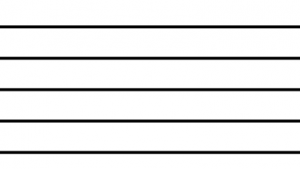
The staff consists of five equally spread out lines, which create four empty spaces. Pitch names are determined by the position of notes on the staff. Notes placed higher on the staff are higher in pitch than notes placed lower on the staff.
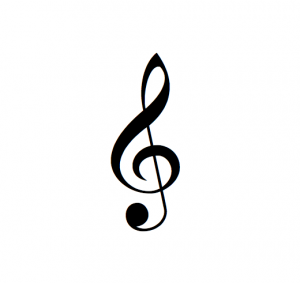
This symbol is called a G-clef. When it is placed on the staff in the manner of the example it is referred to as a treble clef. The treble clef is positioned at the beginning of each staff. Guitar music is written in treble clef, although it sounds an octave lower than written.
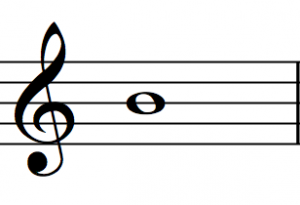
The note ‘B’ is in on the middle line of the staff. Think of in-be-tween. It is played as the second string open.
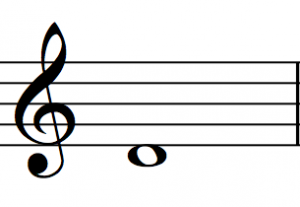
The note ‘D’ is directly below the staff. Think of ‘D’ for down because it is down below the first staff line. It is played as the fourth string open.
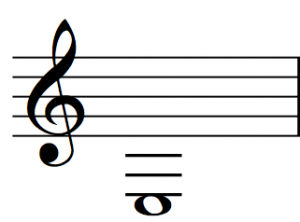
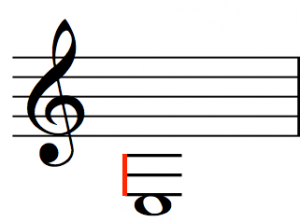
The note ‘E’ is below the third leger line. The extra lines below the staff are called leger lines. Notice that they are evenly spaced and are meant to be an extension of the staff. The note ‘E’ is played as the sixth string open. To remember the pitch ‘E’, imagine a vertical line placed to the left of the three leger lines. Notice how it makes an upper case letter ‘E’ (as shown below).
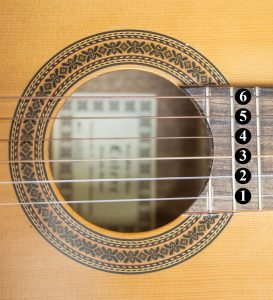
The strings on the guitar are numbered 1 through 6 from the floor upward. For example, the note ‘B’ is played as the second string open.
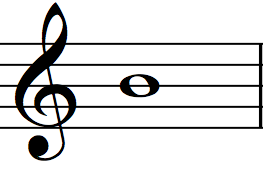
A whole note sustains for 4 beats. The whole note consists of an oval shape that is not colored in.
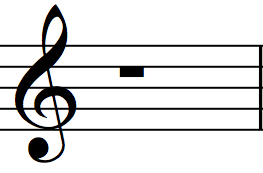
A whole rest creates silence for 4 beats. The whole note rest looks like a top hat placed upside down.
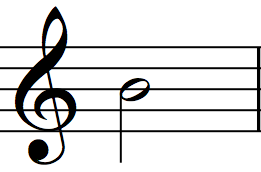
A half note sustains for 2 beats. The half note consists of an open note head and a stem.

A half rest creates silence for 2 beats. The half-note rest looks like a top hat right side up.
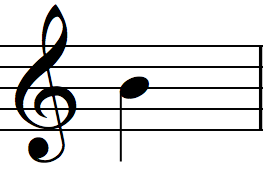
A quarter note sustains for 1 beat. The quarter note consists of a note head that is filled in and a stem.
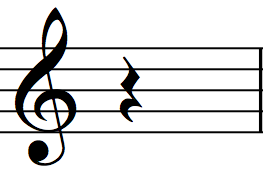
A quarter rest creates silence for 1 beat. The quarter note rest is a somewhat squiggly line.
Note: I have used the note ‘B’ in the pitched examples above for the whole, half and quarter notes. However, any pitch can have any rhythm. Pitches and rhythms are the main building blocks of standard music notation and are combined in countless ways. To be an excellent sight-reader, it is important to be quick at recognizing, processing and playing pitches and rhythms.
Most songs have a steady beat. Composers typically clump the beats into groups of 2, 3 or 4, with an accent placed on the first beat of the group. The following symbols and concepts are essential to understanding rhythm in standard notation.
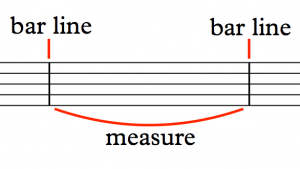
Bar lines divide the staff into measures. A measure is the space between two bar lines. Measures are important because they contain the groups of beats. If the song is grouped into four beats per measure, that means each measure must add up to four beats—no more, no less.
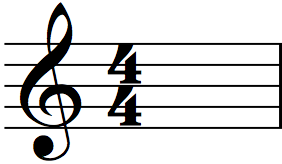
The time signature is placed at the beginning of a piece. It contains two numbers. The top number expresses how many beats are in a measure. The bottom number expresses what type of note value usually receives one beat. Think of the bottom number as a fraction with the number 1 on top. For example, in the case of the time signature to your left, 1/4 refers to a quarter note. Therefore, a 4/4 time signature = 4 x 1/4 notes per measure. Or, put another way, a 4/4 time signature contains four quarter notes per measure.
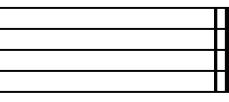
The double bar line marks the end of a musical section. Notice that both vertical lines are the same width.
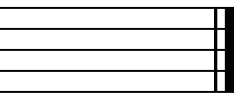
The ending bar line marks the end of an entire composition. Notice that the second line vertical line is thicker than the first.
Let’s Play |
Knowledge of music notation is critical, but knowledge is not enough. Physical posture, mental attitude and good habits contribute to sight-reading successes as well. Throughout the series you will receive sight-reading tips, quotes, proverbs, poems and aphorisms to inspire keep going sight-reading.
Make sure your guitar-playing posture maintains a relatively steady guitar. When your guitar is steady you don’t have to look at your hands very often. To be a good sight-reader your eyes need to be focused on the score, not on your hands. Also, make sure your guitar-playing posture doesn’t unnecessarily strain your muscles or joints. If you have trouble with posture, I suggest you work with a teacher and/or do more careful research on the topic before launching into this series.
The most important attitude for sight-reading is what I call the keep going attitude. The keep going attitude is more concerned with keeping the pulse than perfecting pitches and rhythms. Remember, you are playing exercises. The exercises in this series are not precious. You are playing them for your personal growth, not for a performance. So, don’t worry if the music sounds messy or ugly! The only thing you must actively strive to do is to stay with the pulse.
Have fun! If you make a mistake, I suggest you laugh. Sight-reading does not have to be drudgery. Discovery, irony and even a bit of recklessness are the right attitudes for keep going sight-reading. My mentor, Theodore Norman, used to good-naturedly tease my bad sight-reading with ridiculous descriptions intended to lighten the mood, and it helped. He also advocated that guitarists respond to mistakes by nodding the head up and down, instead of left to right, to create a sense of confidence.
One way to make sight-reading more fun is to do it with another musician. I suggest you do this series with a friend. If that is not possible, treat yourself like a friend.
Count the beats 1-2-3-4- out loud, regardless of what the music demands. In other words, count throughout the entire exercise, even when you have rests. Some students experience difficulty counting out loud and playing at the same time. If you find it difficult, don’t give up! You will be able to master this skill with a bit of practice. Once you have mastered counting out loud while sight-reading, you can easily count silently, in your head.
Let’s Play Rhythms |
It’s time to put this knowledge to practice. Every unit begins with a few play-along exercises that require you to sight-read a variety of rhythms while plucking only one pitch. Click on the blue phrase with the word Score to open the musical notation in another window. Then, click on the play button under Audio to start the play-along track. Wait for the count-in to start the song. Remember, it is critical that you keep up with the beats, even if you make a mistake. Don’t forget to count out loud.
An audio element has been excluded from this version of the text. You can listen to it online here: https://press.rebus.community/sightreadingforguitar/?p=5
An audio element has been excluded from this version of the text. You can listen to it online here: https://press.rebus.community/sightreadingforguitar/?p=5
An audio element has been excluded from this version of the text. You can listen to it online here: https://press.rebus.community/sightreadingforguitar/?p=5
Let’s Play Duets |
At the end of every unit, we will play duets. The duets encourage you to keep up with the beat. In my experience, students who stop to fix mistakes in the middle of an exercise take a long time to learn to sight-read. However, students who keep going with the beat, especially when they make mistakes, learn to sight-read quickly.
Duet notation is different from solo notation. Duet notation includes a brace that joins two staves. The word staves (rhymes with caves) refers to more than one staff. When two ore more staves are joined by brace, the unit is called a system. The system indicates that the music on both staves are to be played at the same time and according to the same pulse.
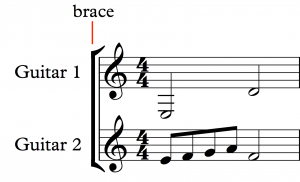
Notice the top staff is labeled Guitar 1 and the bottom staff is labeled Guitar 2. You, the student, will read from the Guitar 1 staff while I play from the Guitar 2 staff in the prerecorded, play-along tracks below. Throughout this series, you are only expected to play Guitar 1. The notation for Guitar 1 has been carefully designed to progressively build upon the concepts introduced in each unit.
An audio element has been excluded from this version of the text. You can listen to it online here: https://press.rebus.community/sightreadingforguitar/?p=5
An audio element has been excluded from this version of the text. You can listen to it online here: https://press.rebus.community/sightreadingforguitar/?p=5
An audio element has been excluded from this version of the text. You can listen to it online here: https://press.rebus.community/sightreadingforguitar/?p=5
An audio element has been excluded from this version of the text. You can listen to it online here: https://press.rebus.community/sightreadingforguitar/?p=5
An audio element has been excluded from this version of the text. You can listen to it online here: https://press.rebus.community/sightreadingforguitar/?p=5
You have completed this unit! If you kept up with the beat and accurately played approximately 70% of the pitches and rhythms, you are ready for the next unit. Feel free to repeat the exercises. However, do not play them so often that you memorize them. Once you memorize the notation, you are no longer developing the skill of sight-reading.
In this unit you will learn three more notes, eighth-note rhythms and two more time signatures. We will continue to follow the same procedure in which you learn symbols and then sight-read them in the Let’s Play section below. Let’s begin!
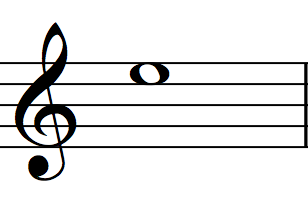
‘E’ is in the top space of the staff. It is played as the first string open.
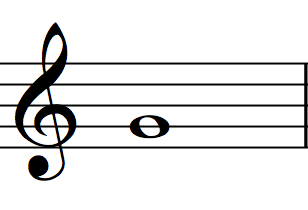
‘G’ is on the second line of the staff. It is played as the third string open.
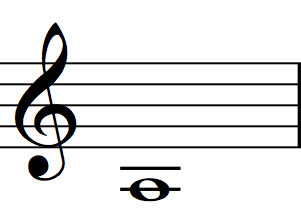
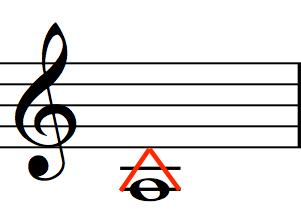
‘A’ is on the leger second line. It is played as the fifth string open. To remember the pitch A, imagine two diagonal lines that touch at the top and run tangentially along the note head. Notice how it makes an upper case letter A.
Rhythms
An eighth note sustains for half of a beat. The eighth note can be written in two ways: either with a beam or a flag.
When eighth notes are grouped, each note consists of a note head that is filled in, a stem and a beam. Notice that the beam connects two eighth notes.
When eighth notes are not grouped each note contains a flag(instead of a beam).
The eighth rest creates silence for half of a beat. It consists of a diagonal line with a small flag.
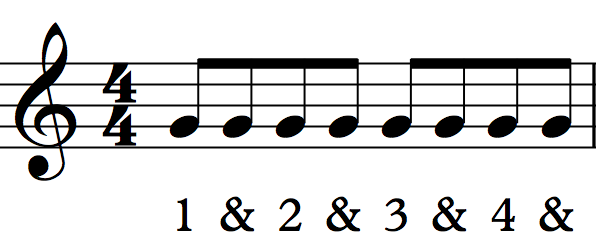
The first half of the beat receives a number that represents the beat’s placement in the measure. The second half of the beat receives the word and (represented by the symbol &). Whenever music contains eighth-note rhythms I suggest you count with ‘&’ throughout the entire piece, even when you encounter quarter, half and whole-note rhythms. This will help you maintain a steady beat.
The 2/4 time signature = 2 x 1/4 notes per measure. In other words, there are 2 quarter notes per measure. When measures contain two beat groupings, musicians refer to the music as being in duple meter. It is important to allow yourself to feel the groupings of twos and accent certain sounds accordingly.
The 3/4 time signature = 3 x 1/4 notes per measure. In other words, there are 3 quarter notes per measure. When measures contain three beat groupings, musicians refer to the music as being in triple meter. It is important to allow yourself to feel the groupings of threes and accent certain sounds accordingly. By the way, 4/4 time is considered quadruple meter because the measures contain four beat groupings.
Let’s Play |
A recent study suggests that sight-reading improves when musicians focus on the feel of the meter, instead of individual beats.Penttinen, Marjaana and Huovinen, Erkki. "The Early Development of Sight-Reading Skills in Adulthood: A Study of Eye Movements." Journal of Research in Music Education, vol. 59, no. 2, 2011, pp. 196-220. To play with the feel of the meter, start by emphasizing the first beat of each measure more than the others.
If you want to learn more about time signatures and meter please visit: http://openmusictheory.com/meter.html
For the last few decades, music educators have studied a phenomenon called chunking. Chunking is when musicians visually perceive patterns rather than individual notes. It turns out that skilled sight-readers chunk.Gromko, Joyce Eastlund. "Predictors of Music Sight-Reading Ability in High School Wind Players." Journal of Research in Music Education, vol. 52, no. 1, 2004, pp. 6-15.
You all chunk when you read words. Most of you see the letters d-o-g and immediately say dog. This is an example of chunking. But, remember what it was like when you had to sound out each individual letter: dee-oh-gee? That is pre-chunking.
The exercises under the heading Let’s Play Patterns are designed to help you process individual notes into patterns as quickly as possible. It is important to trust your instincts. I would rather you attempt to play a pattern and make mistakes than to not try at all.
Let’s Play Rhythms |
An audio element has been excluded from this version of the text. You can listen to it online here: https://press.rebus.community/sightreadingforguitar/?p=27
An audio element has been excluded from this version of the text. You can listen to it online here: https://press.rebus.community/sightreadingforguitar/?p=27
The next exercise will have a two beat count-in because there is a 2/4 time signature at the beginning of the score. Since the smallest rhythmic value in Ex. 2.3 is an eighth note, you need to count 1&2&. From now on, please remember that the count-in always corresponds with the time signature.
An audio element has been excluded from this version of the text. You can listen to it online here: https://press.rebus.community/sightreadingforguitar/?p=27
The next two exercises will have a three beat count-in because there is a 3/4 time signature at the beginning of the each score. Since the smallest rhythmic value in Ex. 2.4 is a quarter note, you simply need to count 123. However, since the smallest rhythmic value in Ex. 2.5 is an eighth note, you need to count 1&2&3&.
An audio element has been excluded from this version of the text. You can listen to it online here: https://press.rebus.community/sightreadingforguitar/?p=27
An audio element has been excluded from this version of the text. You can listen to it online here: https://press.rebus.community/sightreadingforguitar/?p=27
Let’s Play Patterns |
The Let’s Play Patterns category will help you develop the ability to chunk. The exercises in this category are presented as guitar duets.
An audio element has been excluded from this version of the text. You can listen to it online here: https://press.rebus.community/sightreadingforguitar/?p=27
An audio element has been excluded from this version of the text. You can listen to it online here: https://press.rebus.community/sightreadingforguitar/?p=27
An audio element has been excluded from this version of the text. You can listen to it online here: https://press.rebus.community/sightreadingforguitar/?p=27
Let’s Play Duets |
The exercises in this series are progressive and cumulative. They contain information you learned in this unit as well as previous units. As a result, you may need to review the symbols you learned in Unit 1.
An audio element has been excluded from this version of the text. You can listen to it online here: https://press.rebus.community/sightreadingforguitar/?p=27
An audio element has been excluded from this version of the text. You can listen to it online here: https://press.rebus.community/sightreadingforguitar/?p=27
An audio element has been excluded from this version of the text. You can listen to it online here: https://press.rebus.community/sightreadingforguitar/?p=27
You have completed this unit! If you kept up with the beat and accurately played approximately 70% of the pitches and rhythms, you are ready for the next unit. Feel free to repeat the exercises. However, do not play them so often that you memorize them. Once you memorize the notation, you are no longer developing the skill of sight-reading.
In this unit you will learn two fretted notes on the first string and a variety of tempo indicators.
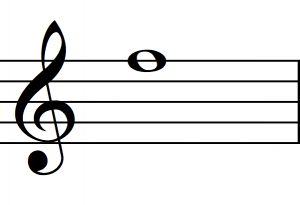
‘F’ is on the top line of the staff. To play ‘F’, fret the first fret on the first string.
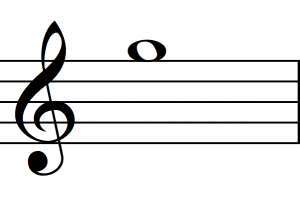
‘G’ sits directly on top of the staff. To play ‘G’, fret the third fret on the first string.
Tempo
Tempo is the speed, or pace, of a piece. It can be conveyed in two ways: in beats per minute (BPM) or with descriptive words.
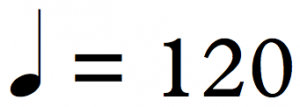
BPM is the most precise way to convey tempo. A rhythmic value is equated to a number that represents beats per minute. In the example, a quarter note equals 120 beats per minute, which means that the pace will unfold as two beats per second. To find an exact BPM, you can purchase a metronome or visit this free site: https://www.metronomeonline.com/.
Descriptive Words
Prior to the invention of the metronome, composers used descriptive words to indicate tempo. Many composers continue to employ these words along with or instead of metronome markings. Below is a list of ten commonly used tempo indicators. Italian words are traditionally used. You will probably encounter other words (in Italian, French, German and other languages) that are not listed here. Most of the time, the definition can be found with an online search.
| Tempo | How to Play | Approx. BPM |
| Largo | broadly | 40-60 |
| Lento | slowly | 45-60 |
| Larghetto | a little faster than Largo | 60-66 |
| Adagio | moderately slow | 66-76 |
| Andante | walking pace | 76-108 |
| Moderato | moderately | 108-120 |
| Allegro | happy, or fast | 120-168 |
| Vivace | lively and fast | 168-176 |
| Presto | very fast | 168-200 |
| Prestissimo | faster than Presto | higher than 200 |
Let’s Play |
If you drop the rhythm—meaning you lose your place while sight-reading—I suggest you play only the first beat of each measure. This will allow you to mentally keep your place in the rhythmic scheme. When that becomes manageable, play only the first and third beats of examples in 4/4 time. Finally, when that becomes manageable, play the entire exercise.
Theodore Norman advocated this method and many guitarists have used it to become great sight-readers. However, this is but one creative solution to a sight-reading obstacle. All great sight-reading guitarists engage in creative problem solving. Think of an obstacle as an opportunity to invent a creative solution. Then, create a solution and put it into action.
Let’s Play Rhythms |
An audio element has been excluded from this version of the text. You can listen to it online here: https://press.rebus.community/sightreadingforguitar/?p=55
An audio element has been excluded from this version of the text. You can listen to it online here: https://press.rebus.community/sightreadingforguitar/?p=55
An audio element has been excluded from this version of the text. You can listen to it online here: https://press.rebus.community/sightreadingforguitar/?p=55
An audio element has been excluded from this version of the text. You can listen to it online here: https://press.rebus.community/sightreadingforguitar/?p=55
An audio element has been excluded from this version of the text. You can listen to it online here: https://press.rebus.community/sightreadingforguitar/?p=55
An audio element has been excluded from this version of the text. You can listen to it online here: https://press.rebus.community/sightreadingforguitar/?p=55
Let’s Play Patterns |
An audio element has been excluded from this version of the text. You can listen to it online here: https://press.rebus.community/sightreadingforguitar/?p=55
Let’s Play Duets |
An audio element has been excluded from this version of the text. You can listen to it online here: https://press.rebus.community/sightreadingforguitar/?p=55
An audio element has been excluded from this version of the text. You can listen to it online here: https://press.rebus.community/sightreadingforguitar/?p=55
An audio element has been excluded from this version of the text. You can listen to it online here: https://press.rebus.community/sightreadingforguitar/?p=55
You have completed this unit! If you kept up with the beat and accurately played approximately 70% of the pitches and rhythms, you are ready for the next unit. Feel free to repeat the exercises. However, do not play them so often that you memorize them. Once you memorize the notation, you are no longer developing the skill of sight-reading.
In this unit you will learn two fretted notes on the second string and articulations.
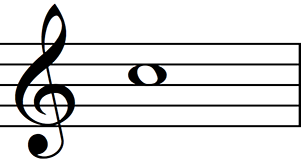
‘C’ is in on the third space of the staff. To play ‘C’, fret the first fret on the second string.
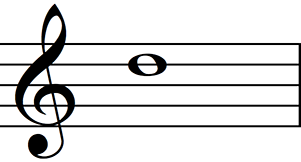
‘D’ is on the fourth line of the staff. To play ‘D’, fret the third fret on the second string.
Articulations direct musicians to vary the emphasis of notes, and control the endings as well as the beginnings of the sounds. A phrase is a collection of notes that can be perceived as a coherent idea. Articulations alter one or more of the following aspects of a note or phrase: dynamic (loud or soft), duration (long or short) or relation to neighboring notes. Some of the most common articulations are described below.
The tenuto is a straight line. It directs you to sustain the note for the full duration of its indicated rhythmic value, or even slightly longer.
The accent is a sideways wedge. It directs you to play the note louder than its surrounding notes.
The marcato is an upward wedge. It directs you to play the note even louder than a note with an accent mark.
The staccato is a dot. It directs you to play the note shorter than its rhythmic value indicates, without speeding up.
The fermata is a semi-circle with a dot in the middle. It directs you to sustain the note(s) for longer than its indicated value, and in accordance to your musical taste. NOTE: Throughout this series, a note with a fermata symbol will be held for twice its indicated duration.
The mezzo-staccato (AKA portato or articulated legato) is a combination of a tenuto and staccato (over one note) or a slur and staccato (over more than one note). It directs you to play the phrase with a smooth yet pulsing articulation.
The breath is a comma. It directs you to pause after its preceding note, without interrupting the flow of the tempo.
The slur is a curved line that connects two or more notes. It directs you to play legato. Legato means to play the notes as a smooth and connected phrase. Sometimes the word legato will appear below the phrase.
The pull-off is a type of slur. It directs you to pluck the string to sound the first note of the group and pull the fretting finger(s) off the string to refresh string vibration for the remaining note(s) of the group. The word pull is misleading since to sound the second note, the fretting finger actually plucks the string, in a downward direction. Pull-offs are usually implied when a slur connects a higher note to a lower note. Sometimes, the letter ‘P’ is placed above the slur.
The hammer-on is another type of slur. It directs you to pluck the string for the first note of the group and hammer the fretting finger(s) onto the string to refresh string vibration for the subsequent note(s) of the group. Hammer-ons are usually implied when a slur connects a lower note to a higher note. Sometimes, the letter ‘H’ is placed above the slur.
The guitar is one of the only instruments that can consistently play multiple notes at once. As a result, one guitar can produce different conceptual elements—such as a bass line, harmony and melody—at the same time. In some genres of guitar music—such as the fugues of J.S. Bach—one guitar can produce concurrent melodies. These different musical elements are referred to as voices. Music notation strives to convey distinct voices on one score by assigning down stems to lower voices (bass) and up stems to higher voices (usually the main melody). The practice of using stem direction to show different voices is meant to help guitarists make sense of the notated musical material.
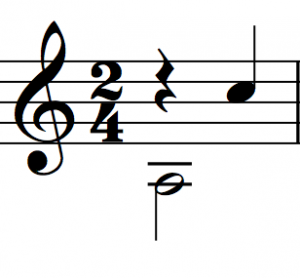
The notation above suggests two voices: a sustained bass note and a melody. Both parts are written in the same measure. The different stem directions set the voices apart. The down stem on note ‘A’ suggests it belongs to a sustained bass note. The up stem on note ‘C’ suggests it belongs to the melody. The quarter rest that precedes ‘C’ belongs to the melody too. Notice that each voice adds up to 2 beats.
Let’s Play |
Cultivate a calm demeanor. It is normal to experience uncomfortable emotions while sight-reading, especially for beginners. Nervousness, frustration, anger, panic, confusion and shame are just a few of the many feelings that arise. Allow calmness to enter into this assortment of emotions, like a ray of light piercing a stormy sky.
Let’s Play Rhythms |
An audio element has been excluded from this version of the text. You can listen to it online here: https://press.rebus.community/sightreadingforguitar/?p=133
An audio element has been excluded from this version of the text. You can listen to it online here: https://press.rebus.community/sightreadingforguitar/?p=133
An audio element has been excluded from this version of the text. You can listen to it online here: https://press.rebus.community/sightreadingforguitar/?p=133
Let’s Play Patterns |
An audio element has been excluded from this version of the text. You can listen to it online here: https://press.rebus.community/sightreadingforguitar/?p=133
An audio element has been excluded from this version of the text. You can listen to it online here: https://press.rebus.community/sightreadingforguitar/?p=133
Let’s Play Duets |
An audio element has been excluded from this version of the text. You can listen to it online here: https://press.rebus.community/sightreadingforguitar/?p=133
An audio element has been excluded from this version of the text. You can listen to it online here: https://press.rebus.community/sightreadingforguitar/?p=133
An audio element has been excluded from this version of the text. You can listen to it online here: https://press.rebus.community/sightreadingforguitar/?p=133
You have completed this unit! If you kept up with the beat and accurately played approximately 70% of the pitches and rhythms, you are ready for the next unit. Feel free to repeat the exercises. However, do not play them so often that you memorize them. Once you memorize the notation, you are no longer developing the skill of sight-reading.
In this unit you will learn two fretted notes on the third string and two types of dotted rhythms. You will also be introduced to the concept of syncopation.
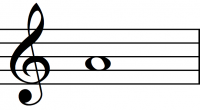
‘A’ is in the second space of the staff. To play ‘A’, fret the second fret on the third string.
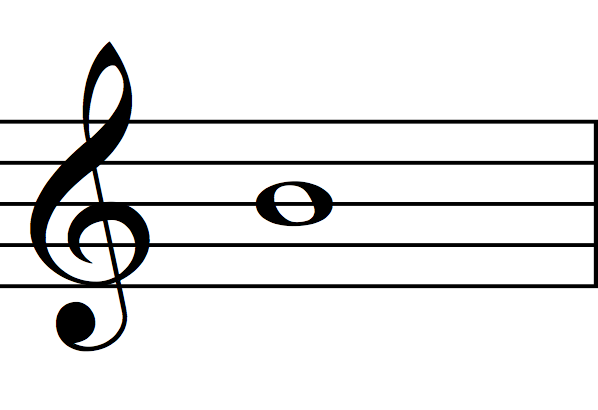
You already learned to read this note as the open second string. However, this same pitch can be played on the fourth fret of the third string as well. When you see this note in music notation you can choose whether you want to play it as the second string/open (AKA no fretting) or the third string/fourth fret.
The rhythmic concepts learned in this unit often create an energizing and exciting musical effect known as syncopation. To understand syncopation you must first understand the terms onbeat and offbeat. Remember how to count eighth notes in 4/4 time?
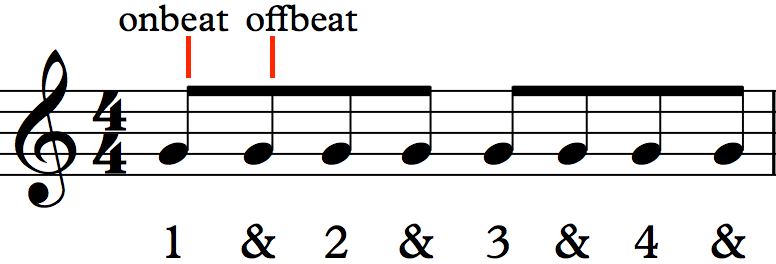
In this example, the onbeats occur on the numbers 1,2,3,4 and the offbeats occur on the &‘s. Onbeats usually get more strength and emphasis than offbeats. The listener expects to hear emphasis on the onbeat. Syncopation plays with those expectations. When syncopation occurs, musical emphasis is either partially, or completely, placed on the offbeats rather than the onbeats. Syncopation can occur for a few beats, or for the entire piece. The following dotted rhythms often facilitate syncopation.
The dotted half note sustains for 3 beats. The dotted half note consists of a half note with a dot positioned close to the notehead.
The dotted half rest creates silence for 3 beats. The dotted half rest consist of a half note rest with a dot positioned to its right.
The dotted quarter note sustains for 1.5 beats. The dotted quarter note consists of a quarter note with a dot positioned close to the notehead.
The dotted quarter rest creates silence for 1.5 beats. The dotted quarter rest consists of a quarter note rest with a dot positioned to its right.
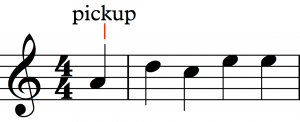
The pickup (AKA anacrusis) is a note, or small collection of notes, that precedes the first downbeat in a musical section or phrase. The downbeat is the first onbeat of each measure.
Let’s Play |
Most people experience difficulty when learning to sight-read syncopated rhythms. Find scores that contain syncopated rhythms and pluck the rhythms only. In other words, ignore the changing pitches and choose only one pitch to play so that you can focus all your attention on sight-reading rhythms. You can apply this approach to the duets in this series.
However, for a more comprehensive resource, I recommend using the book, Modern Reading Text in 4/4 for All Instruments by Louis Bellson and Gil Breines. Make sight-reading rhythms a part of your daily practice. It will increase your confidence and effectiveness in a matter of days!
Let’s Play Rhythms |
An audio element has been excluded from this version of the text. You can listen to it online here: https://press.rebus.community/sightreadingforguitar/?p=224
An audio element has been excluded from this version of the text. You can listen to it online here: https://press.rebus.community/sightreadingforguitar/?p=224
An audio element has been excluded from this version of the text. You can listen to it online here: https://press.rebus.community/sightreadingforguitar/?p=224
Let’s Play Patterns |
An audio element has been excluded from this version of the text. You can listen to it online here: https://press.rebus.community/sightreadingforguitar/?p=224
An audio element has been excluded from this version of the text. You can listen to it online here: https://press.rebus.community/sightreadingforguitar/?p=224
An audio element has been excluded from this version of the text. You can listen to it online here: https://press.rebus.community/sightreadingforguitar/?p=224
Let’s Play Duets |
An audio element has been excluded from this version of the text. You can listen to it online here: https://press.rebus.community/sightreadingforguitar/?p=224
An audio element has been excluded from this version of the text. You can listen to it online here: https://press.rebus.community/sightreadingforguitar/?p=224
An audio element has been excluded from this version of the text. You can listen to it online here: https://press.rebus.community/sightreadingforguitar/?p=224
You have completed this unit! If you kept up with the beat and accurately played approximately 70% of the pitches and rhythms, you are ready for the next unit. Feel free to repeat the exercises. However, do not play them so often that you memorize them. Once you memorize the notation, you are no longer developing the skill of sight-reading.
In this unit you will learn two notes on the fourth string, ornaments and the tie.
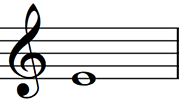
‘E’ is on the first space of the staff. To play ‘E’, fret the second fret on the fourth string.
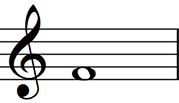
‘F’ is in the first space of the staff. To play ‘F’, fret the third fret on the fourth string.
Ornaments typically embellish melody. However, ornaments can embellish harmony as well. Notice that many of the ornaments described below demand consideration of both pitch and rhythmic duration.
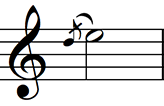
The acciaccatura is a note grouping in which a grace note with a line through the stem ties to a principal note. The grace note is played slightly before the downbeat of the principal note.
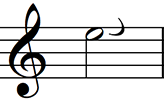
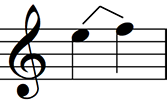
The bend is usually notated as upward curving line, sometimes with an arrow on the end. This symbol leaves the exact pitch of the bent note up to the performer. It can also be notated as two conjoining diagonal lines. This symbol specifies the exact pitch of the bent note. The bend directs you to either push the vibrating string toward the ceiling or pull it toward the floor. Both actions raise the pitch of the vibrating string.
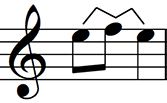
The bend and release is usually notated as upward and downward curving line. It can also be notated as three conjoining diagonal lines. It directs you to pluck, bend and return the string to its starting pitch.
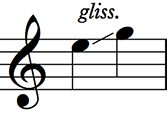
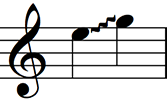
The glissando is commonly written as either a wavy or straight diagonal line connecting two notes. Sometimes the abbreviation ‘gliss.’ for glissando sits atop of the line. The glissando is a continuous slide from the starting to ending note.
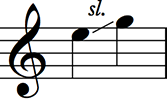
The slide (AKA portamento) is commonly written as a diagonal line. Sometimes the abbreviation ‘sl.’ for slide or ‘port.’ for portamento sits atop the line. Slides can connect two specified notes with a continuous motion, in the manner of a glissando. Yet, sometimes only one note is specified and the performer can determine the other note. Typically, the performer can choose the rhythmic nuance of a slide as well.
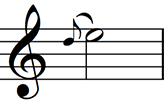
The appoggiatura is a note grouping in which a grace note (the note in small font) ties to a principal note. The grace note is played on the downbeat of the principal note and takes approximately half its rhythmic value.

The tie is a curved line that connects notes of the same staff position and name. Tied notes sustain for the sum of their rhythmic values. Usually, the tie connects two notes across a barline. For guitarists, the tie directs us to initiate the sound by plucking only the first of the two notes and allow the second of the two notes to sustain for its stated duration. In other words, we only pluck once, not twice.

The tie may look like the slur but they function in dramatically different ways. The tie alters rhythm whereas the slur alters articulation. To tell them apart, remember the following: the tie connects two notes of the same pitch whereas the slur connects notes of different pitches.
Let’s Play |
Embrace the unexpected. Sometimes the most innovative sounds and meaningful insights arise during sight-reading. You only get one chance to have a first musical encounter with a piece. Open yourself up to the possibility of an inspiring first impression.
Let’s Play Rhythms |
An audio element has been excluded from this version of the text. You can listen to it online here: https://press.rebus.community/sightreadingforguitar/?p=709
An audio element has been excluded from this version of the text. You can listen to it online here: https://press.rebus.community/sightreadingforguitar/?p=709
An audio element has been excluded from this version of the text. You can listen to it online here: https://press.rebus.community/sightreadingforguitar/?p=709
Let’s Play Patterns |
An audio element has been excluded from this version of the text. You can listen to it online here: https://press.rebus.community/sightreadingforguitar/?p=709
An audio element has been excluded from this version of the text. You can listen to it online here: https://press.rebus.community/sightreadingforguitar/?p=709
Let’s Play Duets |
An audio element has been excluded from this version of the text. You can listen to it online here: https://press.rebus.community/sightreadingforguitar/?p=709
An audio element has been excluded from this version of the text. You can listen to it online here: https://press.rebus.community/sightreadingforguitar/?p=709
An audio element has been excluded from this version of the text. You can listen to it online here: https://press.rebus.community/sightreadingforguitar/?p=709
You have completed this unit! If you kept up with the beat and accurately played approximately 70% of the pitches and rhythms, you are ready for the next unit. Feel free to repeat the exercises. However, do not play them so often that you memorize them. Once you memorize the notation, you are no longer developing the skill of sight-reading.
In this unit you will learn two fretted notes on the sixth string and dynamics.
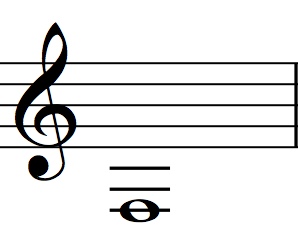
‘F’ is on the third leger line below the staff. To play ‘F’, fret the first fret on the sixth string.
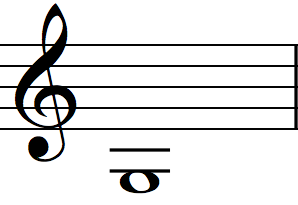
‘G’ is underneath the second leger line below the staff. To play ‘G’, fret the third fret on the sixth string.
The word dynamic refers to variations in loudness. Since music notation developed over a vast period of time and place (and continues to develop) there are a few ways to notate dynamic. The dynamics in this section relate to the Italian words piano (soft), forte (strong) and mezzo (half). The list below includes the symbol, its Italian name and its musical direction. It is organized from the softest to the loudest dynamic.
| Symbol | Italian name | Musical direction |
| ppp | pianississimo | extremely soft |
| pp | pianissimo | very soft |
| p | piano | soft |
| mp | mezzopiano | moderately soft |
| mf | mezzoforte | moderately loud |
| f | forte | loud |
| ff | fortissimo | very loud |
| fff | fortississimo | extremely loud |
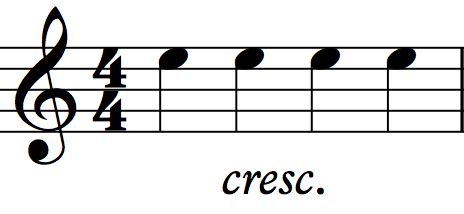
The crescendo, directs you to grow louder. The word means “increasing” in Italian.
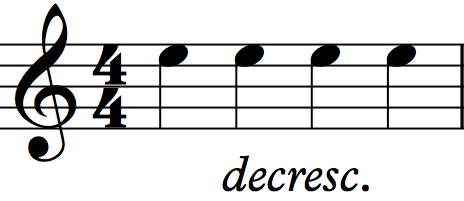
The decrescendo directs you to grow softer. The word means “decreasing” in Italian.
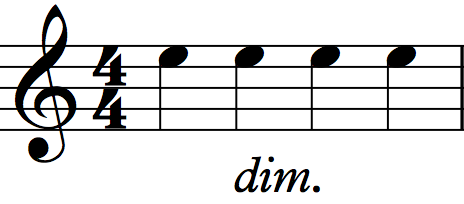
The diminuendo directs you to grow softer. The word means “diminishing” in Italian.
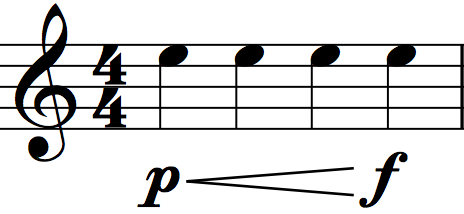
Hairpins direct you to either grow louder or softer over time. They are usually placed under the staff and relate to the notation directly above. A hairpin crescendo that widens from left to right directs you to grow louder.
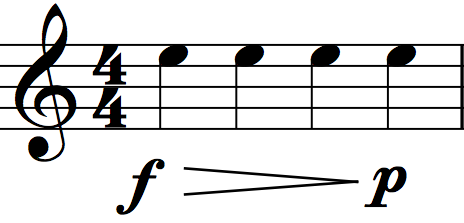
A hairpin decrescendo that narrows from left to right directs you to grow softer.
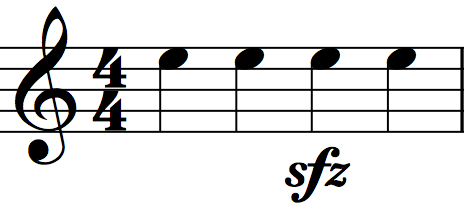
The sforzando involves a sudden and loud accent. It is short for subito forzando, which means “suddenly, with force” in Italian.
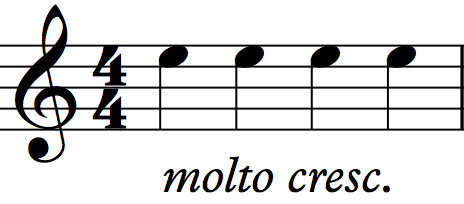
The molto is a modifier that is usually paired with another dynamic (as in the example above). The word means “much” in Italian. It directs you to enact a more dramatic change of dynamic.
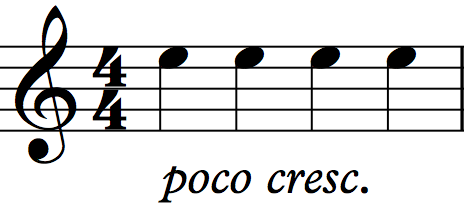
The poco is a modifier that is usually paired with another dynamic (as in the example above). The word means “little” in Italian. It directs you to enact a more subtle change of dynamic.
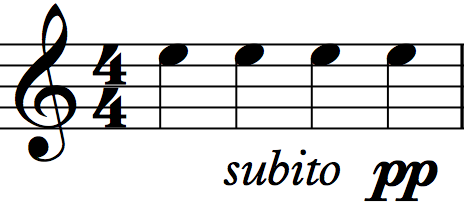
The subito is a modifier that is usually paired with another dynamic (as in the example above). The word means “suddenly” in Italian. It directs you to instantly change dynamic.
Let’s Play |
Dynamic changes force us to listen to the acoustic space, other players and our own playing. Attentive listening can create relaxation and exhilaration at the same time. Become acquainted with the diverse effects of careful listening as you sight-read.
Let’s Play Rhythms |
An audio element has been excluded from this version of the text. You can listen to it online here: https://press.rebus.community/sightreadingforguitar/?p=928
An audio element has been excluded from this version of the text. You can listen to it online here: https://press.rebus.community/sightreadingforguitar/?p=928
An audio element has been excluded from this version of the text. You can listen to it online here: https://press.rebus.community/sightreadingforguitar/?p=928
Let’s Play Patterns |
An audio element has been excluded from this version of the text. You can listen to it online here: https://press.rebus.community/sightreadingforguitar/?p=928
Let’s Play Duets |
An audio element has been excluded from this version of the text. You can listen to it online here: https://press.rebus.community/sightreadingforguitar/?p=928
An audio element has been excluded from this version of the text. You can listen to it online here: https://press.rebus.community/sightreadingforguitar/?p=928
You have completed this unit! If you kept up with the beat and accurately played approximately 70% of the pitches and rhythms, you are ready for the next unit. Feel free to repeat the exercises. However, do not play them so often that you memorize them. Once you memorize the notation, you are no longer developing the skill of sight-reading.
In this unit you will learn simple and compound meters. You will also begin to sight-read compositions created especially for this series!
Simple vs. Compound Meter Explained
In Unit 2 you learned to describe meter in terms of how a measure is broken down into beats. Duple meter is broken into two beats per measure; triple meter into three beats per measure; and quadruple meter into four beats per measure.
The terms introduced in this unit—simple and compound—describe how a beat is broken down into smaller subdivisions. Simply put, beats are typically subdivided (AKA broken down) into twos or threes. Meters that subdivide most of the beats into two equal parts are called simple meters; meters that subdivide most of the beats into three equal parts are called compound meters. This seemingly small distinction makes huge difference in feel. For me, music in simple meter feels angular, whereas music in compound meter feels round. Let’s explore this distinction further.
Both examples below consist of four beats per measure and are therefore in quadruple meter. However, the first one is in simple quadruple meter and the second is in compound quadruple meter.
In simple meter most beats are broken into two equal parts. Notice how the eighth notes are beamed in groups of two to emphasize the subdivision of the beat.
Therefore, in simple meter, each beat is represented by a quarter note.
An audio element has been excluded from this version of the text. You can listen to it online here: https://press.rebus.community/sightreadingforguitar/?p=961

In compound meter most beats are broken into three equal parts. Notice how the eighth notes are beamed in groups of three to emphasize the subdivision of the beat.
Therefore, in compound meter, each beat is represented by a dotted-quarter note.
An audio element has been excluded from this version of the text. You can listen to it online here: https://press.rebus.community/sightreadingforguitar/?p=961
Six Types of Standard Meter
Similarly, duple and triple meters can be expressed in simple and compound as well. Thus, there are six types of standard meter in Western music:
In simple duple meter most beats divide into eighth notes. There are two beats per measure and each beat is a quarter note.
An audio element has been excluded from this version of the text. You can listen to it online here: https://press.rebus.community/sightreadingforguitar/?p=961
In simple triple meter most beats divide into eighth notes. There are three beats per measure and each beat is a quarter note.
An audio element has been excluded from this version of the text. You can listen to it online here: https://press.rebus.community/sightreadingforguitar/?p=961
In simple quadruple meter most beats divide into eighth notes. There are four beats per measure and each beat is a quarter note.
An audio element has been excluded from this version of the text. You can listen to it online here: https://press.rebus.community/sightreadingforguitar/?p=961
In compound duple meter most beats divide into three eighth notes. There are two beats per measure and each beat is equivalent to a dotted-quarter note. This meter can be counted in a variety of ways. The graphic above presents two options. I recommend using the second option because it emphasizes the duple feel.
An audio element has been excluded from this version of the text. You can listen to it online here: https://press.rebus.community/sightreadingforguitar/?p=961
In compound triple meter most beats divide into three eighth notes. There are three beats per measure and each beat is equivalent to a dotted-quarter note. This meter can be counted in a variety of ways. The graphic above presents two options. I recommend using the second option because it emphasizes the triple feel.
An audio element has been excluded from this version of the text. You can listen to it online here: https://press.rebus.community/sightreadingforguitar/?p=961
In compound quadruple meter most beats divide into three eighth notes. There are four beats per measure and each beat is equivalent to a dotted-quarter note. This meter can be counted in a variety of ways. The graphic above presents two options. I recommend using the second option because it emphasizes the quadruple feel.
An audio element has been excluded from this version of the text. You can listen to it online here: https://press.rebus.community/sightreadingforguitar/?p=961
The Hemiola
The hemiola is a device in which rhythmic accents switch from two beats subdivided in three parts to three beats subdivided in two parts (or vice versa). It creates excitement and energy. I suggest you emphasize the change in accent whenever you encounter a hemiola.
When a hemiola appears in compound meter the rhythmic accents switch from two beats subdivided in three parts to three beats subdivided in two parts.
When a hemiola appears in simple meter the rhythmic accents switch from three beats subdivided in two parts to two beats subdivided in three parts.
To determine meter, you can employ the following short cut. Look to the top number of the time signature.
| Simple duple | 2 |
| Simple triple | 3 |
| Simple quadruple | 4 |
| Compound duple | 6 |
| Compound triple | 9 |
| Compound quadruple | 12 |
Simple Meter
As you learned in Unit 2, the bottom number of the time signature, in simple meter, corresponds to the type of note that becomes a single beat (AKA pulse, in this case). Therefore, if the bottom number is ‘4,’ then each beat is represented by a quarter note. It’s pretty simple, which is why it is called simple meter.
Compound Meter
In compound meter, the bottom number of the time signature corresponds to the type of note that becomes a one-third division of the beat (AKA pulse, in this case). If compound meter is notated such that the dotted-quarter note is the beat (as in the examples above) then the eighth note is the one-third division of the dotted-quarter. Hence, the number ‘8’ takes the place of the bottom number of the time signature.
Let’s Play |
Sight-reading empowers you to engage with music you may have never heard before. Many musicians derive oodles of joy from bringing music notation to life for the first hearing. It is like unwrapping a present! Further, sight-reading creates an opportunity to decide whether a piece is worth investing the time needed to make it performance-ready.
When I started sight-reading for the purpose of scouting new performance repertoire, I finally stopped confusing the act of sight-reading with the act of performing. When I sight-read, my goal is to get a sense of the shape, character and difficulties of a piece. Sometimes, mistakes do not get in the way of achieving that goal, which is why they can be ignored. However, when I prepare for performance, my goal is to master the shape, character and difficulties of a piece. In this case, mistakes are crucial to goal attainment. Mistakes are obstacles that, when overcome, clear the path to greater mastery.
I want you to experience the difference between a sight-reading attitude and a performance-preparation attitude. This was one of my motivations for commissioning composers to write over thirty original duet compositions for this series. You do not have to perfect these compositions. All you have to do is sight-read them. If you don’t like the piece, feel free to continue through the series without mastering it. However, if you do like one or more of the compositions, I encourage you to shift from a sight-reading attitude to a performance-preparation attitude so you can add them to your performance repertoire. The original compositions are available in the Appendix as a collection entitled The Obelisks.
Let’s Play Rhythms |
Throughout this unit the count-in click for pieces in compound meter will include the eighth note subdivision of each beat. An emphasis will be placed on the beginning of each beat to help establish the compound meter feel .
An audio element has been excluded from this version of the text. You can listen to it online here: https://press.rebus.community/sightreadingforguitar/?p=961
An audio element has been excluded from this version of the text. You can listen to it online here: https://press.rebus.community/sightreadingforguitar/?p=961
An audio element has been excluded from this version of the text. You can listen to it online here: https://press.rebus.community/sightreadingforguitar/?p=961
Let’s Play Patterns |
An audio element has been excluded from this version of the text. You can listen to it online here: https://press.rebus.community/sightreadingforguitar/?p=961
Let’s Play Duets |
An audio element has been excluded from this version of the text. You can listen to it online here: https://press.rebus.community/sightreadingforguitar/?p=961
An audio element has been excluded from this version of the text. You can listen to it online here: https://press.rebus.community/sightreadingforguitar/?p=961
An audio element has been excluded from this version of the text. You can listen to it online here: https://press.rebus.community/sightreadingforguitar/?p=961
The compositions composed for this series are complied into a collection called The Obelisks. The collection is available for viewing and downloading in the Appendix (forthcoming). I hope you are inspired to perform these pieces and learn about the composers who contributed to this series.
Let’s Play Compositions |
These compositions are under the Creative Commons Attribution-NonCommercial 4.0 International License (CC BY-NC 4.0).
An audio element has been excluded from this version of the text. You can listen to it online here: https://press.rebus.community/sightreadingforguitar/?p=961
An audio element has been excluded from this version of the text. You can listen to it online here: https://press.rebus.community/sightreadingforguitar/?p=961
You have completed this unit! If you kept up with the beat and accurately played approximately 70% of the pitches and rhythms, you are ready for the next unit. Feel free to repeat the exercises. However, do not play them so often that you memorize them. Once you memorize the notation, you are no longer developing the skill of sight-reading.
In this unit you will learn more notes on the first string, accidentals and the eighth-note triplet.
Accidentals are symbols that pair with a notes to create new notes. Three common accidentals are: the sharp (♯), the flat (♭) and the natural (♮).
| Name | Symbol | Effect |
| Sharp | ♯ | The sharp raises pitch up one fret. |
| Flat | ♭ | The flat lowers pitch down one fret. |
| Natural | ♮ | The natural cancels the effect of a sharp or flat. |
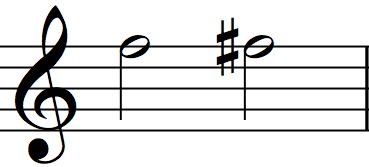
In this example, ‘F’ is played as the first fret/first string. ‘F♯’ is played as the second fret/first string. Since they produce different pitches, they are considered different notes.
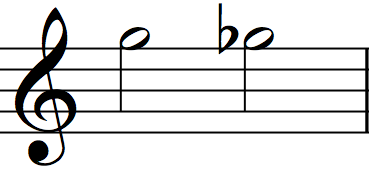
In this example, ‘G’ is played as the third fret/first string. ‘G♭’ is played as the second fret/first string.
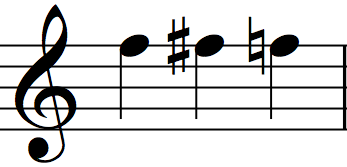
In this example, ‘F’ is played as the first fret/ first string; ‘F♯’ is played as the second fret/first string; ‘F♮’ is played as the first fret/first string again. The natural symbol cancelled the sharp of the previous note.
Notice how the placement of the accidental in speech and writing is different from the placement of the accidental in music notation. For example, the sharp symbol follows the note when we say or write ‘F♯,’ whereas the sharp symbol precedes the note in music notation.
Accidentals apply to successive notes on the same staff position for the remainder of the measure in which they occur, unless explicitly changed by another accidental. The effect of the accidental ends once a barline is passed (there is one exception to this rule, which will be discussed below, under the heading The Tie & Accidentals).
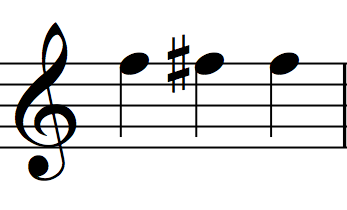
In the example above, the ‘F’ on beat one is played as the first fret, the ‘F♯’ on beat two is played as the second fret and the ‘F♯’ on beat three is played as the second fret as well. The note on beat three is indeed an ‘F♯’ even though the sharp was not added to it in the score.
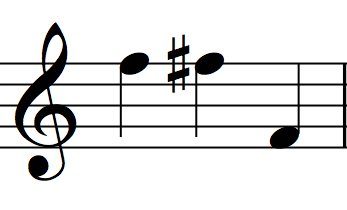
In the example above, the ‘F’ on beat one is played as the first fret/first string, the ‘F♯’ on beat two is played as the second fret/first string and the ‘F’ on beat three is played as the third fret/fourth string. The note on beat three is an ‘F’ (not and ‘F♯’) because the ‘F’ on beat two is a different staff position than the ‘F’ on beat three.
Did you notice in the first two examples that ‘F♯’ and ‘G♭’ are both played as the second fret/first string? ‘F♯’ and ‘G♭’ create the same pitch. For that reason, we call them enharmonic equivalents. Enharmonics (for short) are notes that create the same pitch, despite being notated differently. If you are curious to know more about enharmonics, you may enjoy taking a music theory course.
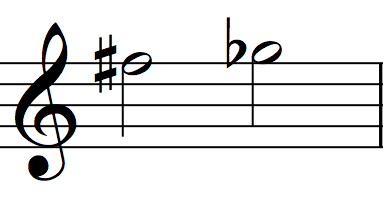
F♯ and G♭are enharmonics. To play ‘F♯’ and ‘G♭’, fret the second fret on the first string.
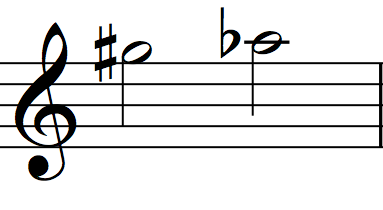
‘G♯’ and ‘A♭’ are enharmonics. To play ‘G♯’ and ‘A♭’, fret the fourth fret on the first string.

‘A’ is on the first leger line above the staff. To play ‘A’, fret the fifth fret on the first string.
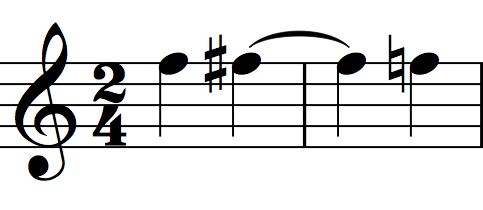
When a note that has been altered by an accidental ties to the same note across a barline, the accidental is carried through. However, subsequent notes at the same staff position in the second bar are not affected by the accidental that was carried through with the tied note.
In this example, the tied note on beat one/measure two is an F♯. However, the note on beat two/measure two is an F natural. Some scores will include the natural as a helpful reminder. This is called a courtesy accidental. Bear in mind that some scores do not include courtesy accidentals. In this case, you are expected to know the rule and play the correct pitch.
In Unit 2 you learned to subdivide the quarter note into two equal parts using eighth notes. The example above contains an eighth-note triplet, which subdivides a quarter note into three equal parts. Notice that three eighth notes are beamed together along with a hovering number ‘3’. The number ‘3’ is what alters the math of the eighth note. In a triplet, each eighth note represents one-third of a beat.
The eighth-note triplet can include a two-third/one-third grouping as well. In the example above, the quarter note sustains for two-thirds of a beat and the eighth note sustains for one-third of a beat.
Let’s Play |
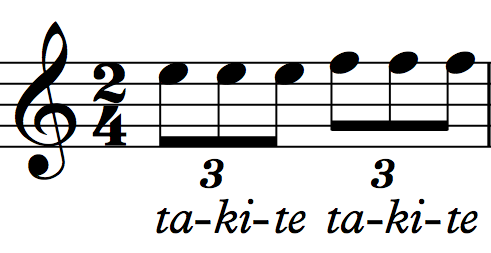
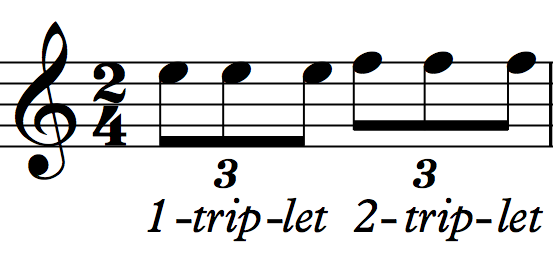
It is important to develop the feel of the triplet subdivision through focused practice. I recommend counting triplets along with a metronome click. Set the metronome to quarter note = 80 BPM and count ‘ta-ki-te’ in the space of every click. Alternatively, you can count ‘1-trip-let, 2-trip-let.’ Make sure the subdivisions are equally spaced and that you say ‘ta‘ or the beat number at the same time as the click. Triplets have a unique feel. You will begin to intuitively transition from the triplet feel to the non-triplet feel and back after dedicated and focused practice.
Let’s Play Rhythms |
An audio element has been excluded from this version of the text. You can listen to it online here: https://press.rebus.community/sightreadingforguitar/?p=1023
An audio element has been excluded from this version of the text. You can listen to it online here: https://press.rebus.community/sightreadingforguitar/?p=1023
An audio element has been excluded from this version of the text. You can listen to it online here: https://press.rebus.community/sightreadingforguitar/?p=1023
An audio element has been excluded from this version of the text. You can listen to it online here: https://press.rebus.community/sightreadingforguitar/?p=1023
Let’s Play Patterns |
An audio element has been excluded from this version of the text. You can listen to it online here: https://press.rebus.community/sightreadingforguitar/?p=1023
An audio element has been excluded from this version of the text. You can listen to it online here: https://press.rebus.community/sightreadingforguitar/?p=1023
Let’s Play Duets |
An audio element has been excluded from this version of the text. You can listen to it online here: https://press.rebus.community/sightreadingforguitar/?p=1023
An audio element has been excluded from this version of the text. You can listen to it online here: https://press.rebus.community/sightreadingforguitar/?p=1023
Let’s Play Compositions |
This composition is under the Creative Commons Attribution-NonCommercial 4.0 International License (CC BY-NC 4.0).
An audio element has been excluded from this version of the text. You can listen to it online here: https://press.rebus.community/sightreadingforguitar/?p=1023
You have completed this unit! If you kept up with the beat and accurately played approximately 70% of the pitches and rhythms, you are ready for the next unit. Feel free to repeat the exercises. However, do not play them so often that you memorize them. Once you memorize the notation, you are no longer developing the skill of sight-reading.
In this unit you will learn more fretted notes on the third string, symbols for small-scale repetition and fingerings.
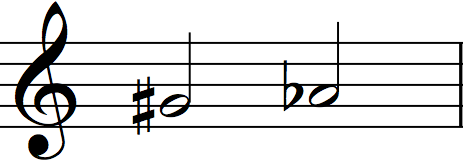
‘G♯’ and ‘A♭’ are enharmonics. To play ‘G♯’ or ‘A♭’, fret the first fret on the third string.
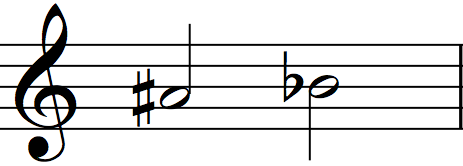
‘A♯’ and ‘B♭’ are enharmonics. To play ‘A♯’ or ‘B♭’, fret the third fret on the third string.

The simile means “in a similar way.” Sometimes it is seen in notation as the abbreviation sim. It directs you to continue playing in the manner previously marked. In the example below, the simile refers to the tenuto articulations.

The one-beat repeat is a diagonal line placed in the middle of the staff. It directs you to repeat the music from the preceding beat. It is important to mention that this symbol is often employed in jazz and popular music and suggests that you strum according to style or personal taste.

The one-measure repeat consists of a diagonal line with a dot on either side that is placed in the middle of an empty measure. It directs you to repeat the music from the preceding measure.
The two-measure repeat consists of two diagonal lines with dots on either side that is placed on the barline between two empty measures. It directs you to play the music from the two preceding measures.

The four-measure repeat consists of four diagonal lines with dots on either side that is placed on the barline between four empty measures. It directs you to play the music from the four preceding measures.
Fingerings specify which fingers to use and where to place them. The plucking-hand and fretting-hand each have a unique set of symbols.
The plucking-hand fingering convention is universal. Each italicized letter corresponds with a Spanish word for a specific finger (with the exception of the pinky finger). See the example below.
| Symbol | Spanish | English |
| p | pulgar | thumb |
| i | indicio | index |
| m | medio | middle |
| a | annular | ring |
| e or x | pinky |
The fretting-hand fingering convention is more complicated because it can involve up to three extra symbols per note. Fingerings can easily clutter the score with too much visual information, which is why I recommend playing from scores in which composers or editors apply fingering notations sparingly. Two fretting-hand fingering conventions are explained in this unit: the standard method and Norman method (named for its inventor, Theodore Norman). Both methods use Arabic numerals to represent fretting-fingers.
| Symbol | Finger |
| 1 | index |
| 2 | middle |
| 3 | ring |
| 4 | pinky |
In the standard method, Arabic numbers (without circles) represent fretting fingers; circled Arabic numbers represent string numbers; and Roman numerals represent fret numbers. See the example of the standard method below.
| Symbol | Direction | |
| Arabic number 3 | Fretting finger | |
| Circled Arabic number 3 | String number | |
| Roman numeral IV | Fret number |
In the Norman method, Arabic numbers (without circles) represent fretting fingers and Roman numerals represent string numbers. Fret numbers are typically not employed in the Norman method because there is only one place per string where a note of the same staff position can be played. Therefore, if you are given the string number you can determine the suggested fret number on your own. See the example of the Norman method below.
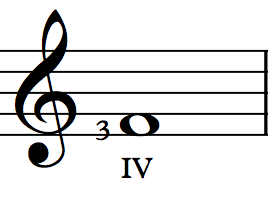
| Symbol | Direction | |
| Arabic number 3 | Fretting finger | |
| Roman numeral IV | String number |
I believe the Norman method is more effective than the standard method at reducing the amount of visual information on the score. It also fosters an intuitive approach to sight-reading. However, because the standard method is more common, it will be applied to most compositions and exercises throughout the series.
Let’s Play |
If the score you intend to sight-read contains a lot of fingerings, do not feel inclined to follow them at first. More often than not, an editor (not a composer) adds fingerings to a score as helpful suggestions. In this case, the editor’s fingerings are not mandatory. However, sometimes a composer will assign fingerings in order to achieve a particular timbre or phrasing. In this case, fingerings provide deeper insight into a composer’s musical intentions. In either case, fingerings do not need to factor into a first or second sight-reading encounter. Remember, too much visual information on the page can slow down mental processing.
Let’s Play Rhythms |
An audio element has been excluded from this version of the text. You can listen to it online here: https://press.rebus.community/sightreadingforguitar/?p=1066
An audio element has been excluded from this version of the text. You can listen to it online here: https://press.rebus.community/sightreadingforguitar/?p=1066
An audio element has been excluded from this version of the text. You can listen to it online here: https://press.rebus.community/sightreadingforguitar/?p=1066
An audio element has been excluded from this version of the text. You can listen to it online here: https://press.rebus.community/sightreadingforguitar/?p=1066
Let’s Play Patterns |
Remember, Roman numerals represent string numbers.
An audio element has been excluded from this version of the text. You can listen to it online here: https://press.rebus.community/sightreadingforguitar/?p=1066
In the next exercise, the simile in measure 3 directs you to continue accenting in the manner of measures 1 and 2.
An audio element has been excluded from this version of the text. You can listen to it online here: https://press.rebus.community/sightreadingforguitar/?p=1066
An audio element has been excluded from this version of the text. You can listen to it online here: https://press.rebus.community/sightreadingforguitar/?p=1066
Let’s Play Duets |
An audio element has been excluded from this version of the text. You can listen to it online here: https://press.rebus.community/sightreadingforguitar/?p=1066
Let’s Play Compositions |
These compositions are under the Creative Commons Attribution-NonCommercial 4.0 International License (CC BY-NC 4.0).
The piece below provides two sight-reading opportunities. I suggest you sight-read the Guitar 1 melody first and the vocal melody second.
An audio element has been excluded from this version of the text. You can listen to it online here: https://press.rebus.community/sightreadingforguitar/?p=1066
An audio element has been excluded from this version of the text. You can listen to it online here: https://press.rebus.community/sightreadingforguitar/?p=1066
You have completed this unit! If you kept up with the beat and accurately played approximately 70% of the pitches and rhythms, you are ready for the next unit. Feel free to repeat the exercises. However, do not play them so often that you memorize them. Once you memorize the notation, you are no longer developing the skill of sight-reading.
In this unit you will learn more fretted notes on the fourth string, sixteenth rhythms and dotted eighth rhythms. You will also learn how to apply these rhythms in both simple and compound meters.
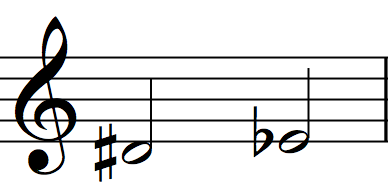
‘D♯’ and ‘E♭’ are enharmonics. To play ‘D♯’ or ‘E♭’, fret the first fret on the fourth string.
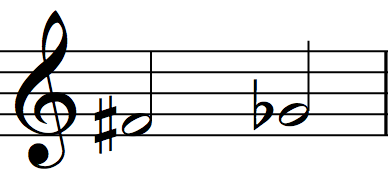
‘F♯’ and ‘G♭’ are enharmonics. To play ‘F♯’ or ‘G♭’, fret the fourth fret on the fourth string.

You already learned to read this note as the open third string. However, this same pitch can be played as the fifth fret of the fourth string as well.
In simple meter, a sixteenth note sustains for one-quarter of a beat. The sixteenth note can be written in two ways: either with two beams or two flags.
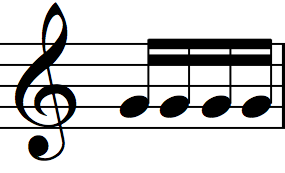
Four sixteenth notes are written here. The sixteenth note consists of a note head that is colored in, a stem and two beams. In this example, the beam connects four sixteenth notes. Four sixteenth notes add up to one quarter note.
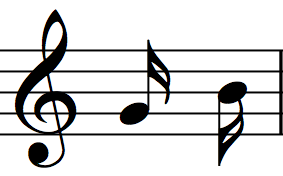
In this example, the sixteenth notes contain flags instead of beams.
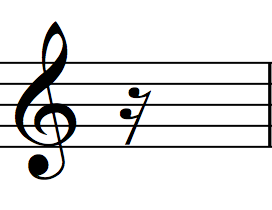
A sixteenth rest creates silence for one-quarter of a beat. The sixteenth rest consists of a diagonal line with two small flags.

The first sixteenth receives a number, which represents the beat’s placement in the measure. The second sixteenth receives the sound ‘ee.’ The third sixteenth receives the word ‘&.’ The fourth sixteenth receives the sound ‘ah.’ When you play music with sixteenth rhythms, I suggest you count with “1e&a…” throughout the entire piece, even when you encounter eighth, quarter, half and whole note rhythms. This will help you maintain a steady beat. View the video above for examples of counting throughout this unit.
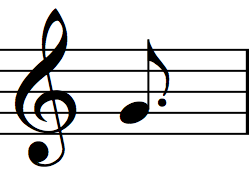
The dotted eighth note sustains for three-quarters of a beat. The dotted eighth note consists of an eighth note with a dot positioned close to the notehead.
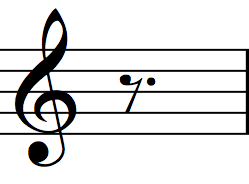
The dotted eighth rest creates silence for three-quarters of a beat. The dotted eighth rest consists of an eighth rest with a dot positioned close to the symbol.
An audio element has been excluded from this version of the text. You can listen to it online here: https://press.rebus.community/sightreadingforguitar/?p=1068
Since the dotted eighth holds for three-quarters of a beat and the sixteenth holds for one-quarter of a beat, they frequently beam together to form a group that adds up to one beat. The example above shows two combinations that frequently appear in music.
An audio element has been excluded from this version of the text. You can listen to it online here: https://press.rebus.community/sightreadingforguitar/?p=1068
Eighth notes and sixteenth notes also frequently beam together to adds up to one beat. The example above shows three possible combinations.
An audio element has been excluded from this version of the text. You can listen to it online here: https://press.rebus.community/sightreadingforguitar/?p=1068
In Unit 9 you learned the following about compound meter: the dotted quarter note sustains for a beat and the eighth note sustains for one-third of a beat. Therefore, the sixteenth note sustains for one-sixth of a beat. The graphic above shows two possible ways of counting sixteenths in compound meter.
An audio element has been excluded from this version of the text. You can listen to it online here: https://press.rebus.community/sightreadingforguitar/?p=1068
Eighth notes and sixteenth notes frequently beam together to form groups that add up to one beat. The example above shows three of the many possible combinations.
An audio element has been excluded from this version of the text. You can listen to it online here: https://press.rebus.community/sightreadingforguitar/?p=1068
In compound meter, the dotted the eighth note sustains for one-half of a beat. The dotted eighth note is usually paired with a sixteenth note. One possible combination is above.
Let’s Play |
The score is a like map that leads you as an explorer to the site of musical treasure. Once there, you have to dig deep into the notation to unearth musical gems.
Some composers are explicit about the type of musical treasure they want you to find. For example, in this series, Mark Popeney, Bahaa El Ansary and Ashraf Fouad are detailed and precise about dynamics, ornaments and articulations. As a classical musician, I strive to achieve the composer’s vision by playing all the notations on the score. I encourage you to do the same.
However, it is important to note that some composers deliberately create scores free of extra notations. Typically, these composers entrust you to add dynamics, ornaments and articulations according to your artistic sensibility. It helps to know the composer’s influences or understand the genre’s stylistic features. For example, Brandon Mayer’s compositions suggest a bluegrass aesthetic and Emile Porée’s pieces evoke a jazz style.
Let’s Play Rhythms |
An audio element has been excluded from this version of the text. You can listen to it online here: https://press.rebus.community/sightreadingforguitar/?p=1068
The following piece uses beams over rests to help emphasize beat groupings. Some musicians believe sight-reading is easier when this type of rhythmic notation is used.
An audio element has been excluded from this version of the text. You can listen to it online here: https://press.rebus.community/sightreadingforguitar/?p=1068
An audio element has been excluded from this version of the text. You can listen to it online here: https://press.rebus.community/sightreadingforguitar/?p=1068
An audio element has been excluded from this version of the text. You can listen to it online here: https://press.rebus.community/sightreadingforguitar/?p=1068
An audio element has been excluded from this version of the text. You can listen to it online here: https://press.rebus.community/sightreadingforguitar/?p=1068
Let’s Play Patterns |
An audio element has been excluded from this version of the text. You can listen to it online here: https://press.rebus.community/sightreadingforguitar/?p=1068
An audio element has been excluded from this version of the text. You can listen to it online here: https://press.rebus.community/sightreadingforguitar/?p=1068
Let’s Play Duets |
An audio element has been excluded from this version of the text. You can listen to it online here: https://press.rebus.community/sightreadingforguitar/?p=1068
An audio element has been excluded from this version of the text. You can listen to it online here: https://press.rebus.community/sightreadingforguitar/?p=1068
An audio element has been excluded from this version of the text. You can listen to it online here: https://press.rebus.community/sightreadingforguitar/?p=1068
Let’s Play Compositions |
These compositions are under the Creative Commons Attribution-NonCommercial 4.0 International License (CC BY-NC 4.0).
An audio element has been excluded from this version of the text. You can listen to it online here: https://press.rebus.community/sightreadingforguitar/?p=1068
Throughout this series, you are welcome to play on any type of guitar you choose (nylon string, steel string or electric.). However, if you would eventually like to perform the following piece, please note that the composer recommends using a steel-string guitar.
An audio element has been excluded from this version of the text. You can listen to it online here: https://press.rebus.community/sightreadingforguitar/?p=1068
Cueurs Desolez Par Toutes Nations is ultimately meant for voice with guitar accompaniment. However, the vocal part is perfect for your guitar sight-reading practice. Please play the vocal part on your guitar and if you like it, try singing along!
An audio element has been excluded from this version of the text. You can listen to it online here: https://press.rebus.community/sightreadingforguitar/?p=1068
Process I is a great piece for sight-reading variations on sixteenth rhythms. However, you may want to approach this piece a bit differently from the others on account of a few issues. The main issue is that the MIDI Guitar 2 audio (below) contains tremolos that sound more like technical glitches than actual guitar tremolos (note that a real Guitar 2 part will be added eventually). If the Guitar 2 part is too distracting, you may want to simply play Guitar 1 along with a metronome click. The secondary issue is that the piece is long. I suggest you sight-read the rhythms on one pitch first and then sight-read the whole piece (or a significant section of it).
An audio element has been excluded from this version of the text. You can listen to it online here: https://press.rebus.community/sightreadingforguitar/?p=1068
You have completed this unit! If you kept up with the beat and accurately played approximately 70% of the pitches and rhythms, you are ready for the next unit. Feel free to repeat the exercises. However, do not play them so often that you memorize them. Once you memorize the notation, you are no longer developing the skill of sight-reading.
In this unit you will learn more fretted notes on the fifth string, expression indicators and tuplets.
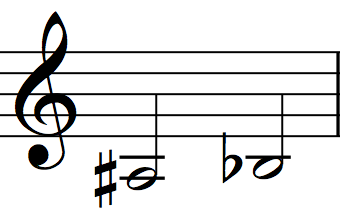
‘A♯’ and ‘B♭’ are enharmonics. To play ‘A♯’ or ‘B♭’, fret the first fret on the fifth string.

‘C♯’ and ‘D♭’ are enharmonics. To play ‘C♯’ or ‘D♭’, fret the fourth fret on the fifth string.

You already learned to read this note as the open fourth string. However, this same pitch can be played as the fifth fret of the fifth string as well.
The following five words, or abbreviations, frequently appear in scores to make music more expressive. View the video for examples of the concepts presented in this unit.
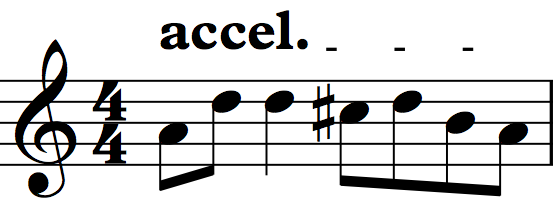
The accelerando, or accel. for short, directs you to gradually increase tempo. If a line of dashes accompanies the command, increase tempo until you reach the end of the dashes. If the accel. appears alone, continue increasing tempo until you hit another indicator (usually a tempo).
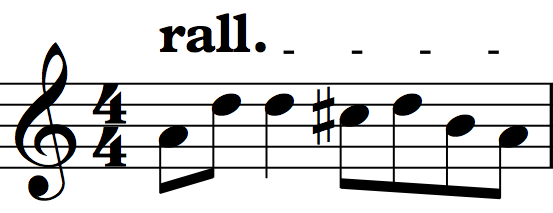
The rallentando, or rall. for short, directs you to gradually decrease tempo.
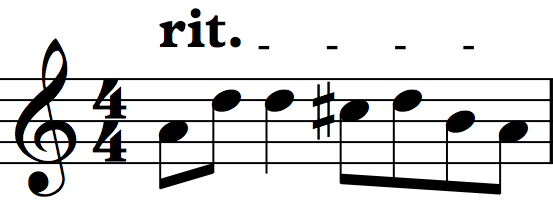
The ritardando, or rit. for short, directs you to gradually decrease tempo. Debates abound regarding the subtle differences between rit. and rall.
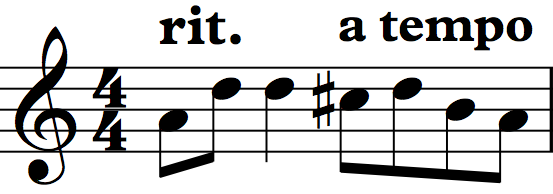
The marking, a tempo, directs you to resume the original tempo or the tempo maintained prior to an accel., rall. or rit.
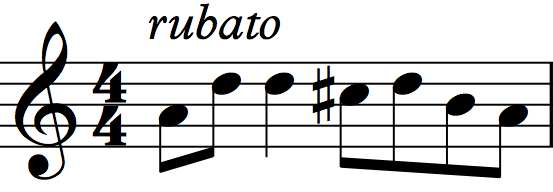
The rubato directs you to lengthen and shorten the duration of beats at your discretion. This indication affords ample space for personal expression. Rubato can be applied in various ways, which is why you may want to explore the topic further.
The following adjectives modify other musical commands.

Poco means ‘a little’ in Italian. For example, poco accel. means to accelerate a little.

Molto means ‘very’ in Italian. For example, molto accel. means to accelerate a lot.
Tuplets are groups of rhythms equally subdivided across a specific duration in a way that is irregular in the context of the time signature. You already learned a tuplet. Remember the eighth-note triplet discussed in Unit 10?
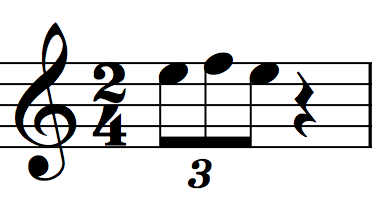
The triplet is considered irregular because the three eighth notes of a triplet add up to one quarter note. Bear in mind that the regular rules of rhythm dictate that three eighth notes should equal a dotted half note. The number ‘3’ (placed either above or below the triplet) temporarily alters the rules from regular to irregular. According to irregular rules, each eighth note in the triplet equals one-third of a beat. All tuplets, like the triplet, have a number placed either above or below them to signal the shift from regular to irregular rules. Here are two more common tuplets.
The example above is in simple duple meter. In this meter, the quarter note gets the pulse. The second beat is a sixteenth note quintuplet, which indicates five equally spaced rhythms across the duration of a quarter note.
The example above is in compound duple meter. In this meter the dotted-quarter note gets the pulse. The second beat is an eighth note duplet, which indicates two equally spaced rhythms across the duration of a dotted-quarter note.
Let’s Play |
Expressive sight-reading is fun! Use your intuition to play with feeling and musicality, even if you are playing a piece for the first time.
A fluid pulse can enhance expressive playing. Indulge in the human tendency to create a pulse that waxes and wanes. It is tempting to think that excellent musicianship is achieved by playing with a metronome. However, in my experience, the most exhilarating (and excellent) musical experiences happen while playing with other musicians, not a metronome or a click.
The expression indicators introduced in this unit are often impossible to implement while playing with a click. If possible, I recommend that you sight-read this unit’s exercises with another musician. If it is not possible, then play with the pre-recorded tracks below but be aware that, in some cases, you will not be able to follow the expression markings.
Let’s Play Rhythms |
An audio element has been excluded from this version of the text. You can listen to it online here: https://press.rebus.community/sightreadingforguitar/?p=1170
An audio element has been excluded from this version of the text. You can listen to it online here: https://press.rebus.community/sightreadingforguitar/?p=1170
An audio element has been excluded from this version of the text. You can listen to it online here: https://press.rebus.community/sightreadingforguitar/?p=1170
An audio element has been excluded from this version of the text. You can listen to it online here: https://press.rebus.community/sightreadingforguitar/?p=1170
Let’s Play Patterns |
An audio element has been excluded from this version of the text. You can listen to it online here: https://press.rebus.community/sightreadingforguitar/?p=1170
An audio element has been excluded from this version of the text. You can listen to it online here: https://press.rebus.community/sightreadingforguitar/?p=1170
Let’s Play Duets |
An audio element has been excluded from this version of the text. You can listen to it online here: https://press.rebus.community/sightreadingforguitar/?p=1170
An audio element has been excluded from this version of the text. You can listen to it online here: https://press.rebus.community/sightreadingforguitar/?p=1170
An audio element has been excluded from this version of the text. You can listen to it online here: https://press.rebus.community/sightreadingforguitar/?p=1170
Let’s Play Compositions |
These compositions are under the Creative Commons Attribution-NonCommercial 4.0 International License (CC BY-NC 4.0).
An audio element has been excluded from this version of the text. You can listen to it online here: https://press.rebus.community/sightreadingforguitar/?p=1170
An audio element has been excluded from this version of the text. You can listen to it online here: https://press.rebus.community/sightreadingforguitar/?p=1170
An audio element has been excluded from this version of the text. You can listen to it online here: https://press.rebus.community/sightreadingforguitar/?p=1170
The standard method of fingering applies to the next composition. The composer, Bahaa El Ansary, chose to represent string numbers with circled Arabic numerals.
An audio element has been excluded from this version of the text. You can listen to it online here: https://press.rebus.community/sightreadingforguitar/?p=1170
You have completed this unit! If you kept up with the beat and accurately played approximately 70% of the pitches and rhythms, you are ready for the next unit. Feel free to repeat the exercises. However, do not play them so often that you memorize them. Once you memorize the notation, you are no longer developing the skill of sight-reading.
In this unit you will learn more fretted notes on the sixth string and a few unique meters.
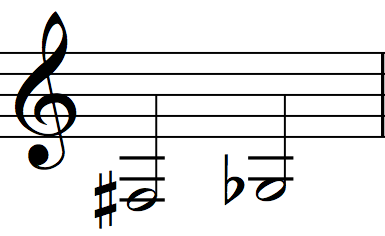
‘F♯’ and ‘G♭’ are enharmonics. To play ‘F♯’ or ‘G♭’, fret the second fret on the sixth string.
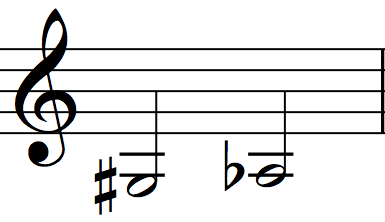
‘G♯’ and ‘A♭’ are enharmonics. To play ‘G♯’ or ‘A♭’, fret the fourth fret on the sixth string.

You already learned to read this note as the open fifth string. However, this same pitch can be played as the fifth fret of the sixth string as well.
The meter above is in compound duple. Each beat is equal to a dotted half note and is subdivided into three equal parts. Each subdivision is represented by a quarter note. It has the same feel as 6/8 meter. You can practice this meter in Capriccio.
The meter above features three beats per measure. Each beat is represented by a half note. The half note beat often corresponds with a slower tempo. Further, half notes have the potential to be subdivided further than quarter notes. As a result, meters with a half note pulse often showcase highly-ornamented melodies, as is the case in European dance music from the Baroque era. You can practice this meter in Courante.
The meter above features one beat per measure. Each beat is a half note. This meter can apply to some European music from the Renaissance, but is rarely used today. You can practice this meter in Con qué la lavaré?

The example above is in mixed meter. A piece in mixed meter will feature two or more different time signatures in the same piece. New time signatures appear at the beginning of a measure. Subsequent measures continue in the previous time signature until a new time signature is introduced. You can practice this meter in Mark Popeney’s Brief Moments, After.
Meters that do not fit into the duple, triple or quadruple metric groupings are referred to as complex. Often, the beats in complex meter are grouped asymmetrically.
The samaie (samai’i), from the Turko-Arab tradition, will serve as an example of complex meter. Its 10/8 time signature indicates ten subdivisions per measure. Notice how the composer breaks the 10 subdivisions into groups of 3+4+3 via dotted bar lines (from Unit 18’s Guitar Samaie). It is further implied that rhythmic emphasis should be placed on the first eighth note of each group. As a result, you will count either:
ONE, two, three, FOUR, five six, seven, EIGHT, nine, ten
ONE, two, three, ONE, two, three, four, ONE, two, three

Meters with additive rhythms feature a time signature in which the top number can be broken into two or more asymmetrical beat groupings. Sometimes the top number of the time signature is written as an addition equation to reference the exact subdivisions.
Many musical traditions feature song forms in additive meter. Much of the world’s music was (and is) orally transmitted. Musicians in these traditions rely on memory and their knowledge of the style, not notation. A few of these traditions have recently adopted music notation. However, music notation often falls short of communicating the stylistic nuances of a tradition. If a piece is inspired by an oral musical tradition, I suggest you research its style, culture and form.
The paidushko, from the Balkan tradition will serve as an example of this phenomenon. Its 2+3/8 additive time signature indicates two pulses per measure, shown as sub-groups of 2 eighth notes + 3 eighth notes. You can practice this in Paidushko. Notice how the beaming patterns and placement of ornaments reinforce the 2+3 feel. As a result, you will count either:
ONE, two, THREE, four, five
ONE, two, ONE, two, three

Let’s Play |
The meters introduced in this unit are not as complicated or challenging as they may appear at first glance. Many of them are associated with dances. A piece in mixed, additive or unusual meter can seem difficult when looking at its notation but is actually intuitive when you find its groove. Often a piece’s rhythmic logic just needs to get off the page and into the body. Before you start sight-reading a piece, spend time moving and singing with the groove of its meter.
Let’s Play Rhythms |
An audio element has been excluded from this version of the text. You can listen to it online here: https://press.rebus.community/sightreadingforguitar/?p=1186
An audio element has been excluded from this version of the text. You can listen to it online here: https://press.rebus.community/sightreadingforguitar/?p=1186
An audio element has been excluded from this version of the text. You can listen to it online here: https://press.rebus.community/sightreadingforguitar/?p=1186
An audio element has been excluded from this version of the text. You can listen to it online here: https://press.rebus.community/sightreadingforguitar/?p=1186
An audio element has been excluded from this version of the text. You can listen to it online here: https://press.rebus.community/sightreadingforguitar/?p=1186
Let’s Play Patterns |
An audio element has been excluded from this version of the text. You can listen to it online here: https://press.rebus.community/sightreadingforguitar/?p=1186
An audio element has been excluded from this version of the text. You can listen to it online here: https://press.rebus.community/sightreadingforguitar/?p=1186
An audio element has been excluded from this version of the text. You can listen to it online here: https://press.rebus.community/sightreadingforguitar/?p=1186
Let’s Play Duets |
An audio element has been excluded from this version of the text. You can listen to it online here: https://press.rebus.community/sightreadingforguitar/?p=1186
An audio element has been excluded from this version of the text. You can listen to it online here: https://press.rebus.community/sightreadingforguitar/?p=1186
An audio element has been excluded from this version of the text. You can listen to it online here: https://press.rebus.community/sightreadingforguitar/?p=1186
An audio element has been excluded from this version of the text. You can listen to it online here: https://press.rebus.community/sightreadingforguitar/?p=1186
An audio element has been excluded from this version of the text. You can listen to it online here: https://press.rebus.community/sightreadingforguitar/?p=1186
Let’s Play Compositions |
These compositions are under the Creative Commons Attribution-NonCommercial 4.0 International License (CC BY-NC 4.0).
An audio element has been excluded from this version of the text. You can listen to it online here: https://press.rebus.community/sightreadingforguitar/?p=1186
An audio element has been excluded from this version of the text. You can listen to it online here: https://press.rebus.community/sightreadingforguitar/?p=1186
The Guitar 1 part of the next exercise was originally a vocal melody. Play the melody on the guitar first and then, if you want, sing it too.
An audio element has been excluded from this version of the text. You can listen to it online here: https://press.rebus.community/sightreadingforguitar/?p=1186
You have completed this unit! If you kept up with the beat and accurately played approximately 70% of the pitches and rhythms, you are ready for the next unit. Feel free to repeat the exercises. However, do not play them so often that you memorize them. Once you memorize the notation, you are no longer developing the skill of sight-reading.
In this unit you will learn more fretted notes on the first string, key signatures and cut time meter.
‘A♯’ and ‘B♭’ are enharmonics. To play ‘A♯’ or ‘B♭’, fret the sixth fret on the first string.
‘B’ sits on top of the first leger line above the staff. To play ‘B’, fret the seventh fret on the first string.
‘C’ is in the second leger line above the staff. To play ‘C’, fret the eighth fret on the first string.
Key signatures serve two important functions. First, they free the score of too much visual information, which in turn aids sight-reading. Second, they designate the key of the piece. A theoretical understanding of keys is useful, but not necessary for sight-reading. As long as you understand the rules outlined below you will be able to play music with key signatures. However, if you want to learn more about music theory, I advise you to enroll in a music theory course, or teach yourself via MusicTheory.net.
The key signature is situated directly to the right of the treble clef. It usually contains a set of one or more sharps or flats. The key signature establishes the following rules:
The key signature above contains two sharps. The center points of the sharps are positioned where ‘F’ and ‘C’ are placed on the staff. This means that all ‘F’s and ‘C’s, in all pitch registers, are to be played sharp, even though sharp signs will not precede the notes in the score. In the example above, the notes to be played are F♯, F♯, C♯ & C♯.
The key signature above demands that all ‘F’s and ‘C’s are to be played sharp, unless ‘undone’ by a natural symbol. Notice the natural on beat two. The notes you must play in the example are: F♯, F-natural, C♯ & F♯.
Take a moment to familiarize yourself with the key signatures below that contain accidentals. Please note that key signatures usually contain either all sharps or all flats. However, a key signature can exists without sharps or flats as well. Two of the most common key signatures are entirely free of accidentals.
Cut time is a fairly common meter. It typically appears in the time signature as a ‘C’ pierced by a vertical line.
Cut time can also be represented by a 2/2 time signature (or with the phrase alla breve ).
The rhythmic notation in cut time can look like the rhythmic notation in common time (AKA simple quadruple meter). However, the main difference between them has to do with rhythmic emphasis.
In the example above, notice how the beat accent falls on every half note in cut time and on every quarter note in common time. Think of cut time as having 50% fewer pulses than common time. This significantly alters the difference in feel between cut time and common time. Play the two following examples to get a sense of the difference in feel.
Let’s Play |
Remember to look at the key signature and time signature before you start sight-reading. Beginning sight-readers may forget to alter notes displayed in the key signature. With practice, it will become easier to remember which pitches to alter. Start with key signatures that have between 1-3 sharps or flats and then work your way up to key signatures with 4-7 sharps or flats. Before starting a piece, I recommend improvising in its key (if you already know this concept). This habit will train your mind and fingers to execute the altered notes with intuitive ease.
Let’s Play Rhythms |
The following exercise is in a cut time meter. Since there are two half note pulses per measure, the count-in bell will be struck two times.
An audio element has been excluded from this version of the text. You can listen to it online here: https://press.rebus.community/sightreadingforguitar/?p=1197
Remember to check the key signature before you sight-read! The next exercise contains a B-flat in the key signature.
An audio element has been excluded from this version of the text. You can listen to it online here: https://press.rebus.community/sightreadingforguitar/?p=1197
The next exercise is in mixed meter. Take a moment to understand the logic of the changing meters before you sight-read. I’ve added suggestions for counting on the score. Notice the repeat signs as well.
An audio element has been excluded from this version of the text. You can listen to it online here: https://press.rebus.community/sightreadingforguitar/?p=1197
Let’s Play Patterns |
The next exercise contains an F-sharp in the key signature.
An audio element has been excluded from this version of the text. You can listen to it online here: https://press.rebus.community/sightreadingforguitar/?p=1197
The next exercise contains a B-flat in the key signature.
An audio element has been excluded from this version of the text. You can listen to it online here: https://press.rebus.community/sightreadingforguitar/?p=1197
The next exercise contains an F-sharp and a C-sharp in the key signature.
An audio element has been excluded from this version of the text. You can listen to it online here: https://press.rebus.community/sightreadingforguitar/?p=1197
The next exercise contains a B-flat and an E-flat in the key signature.
An audio element has been excluded from this version of the text. You can listen to it online here: https://press.rebus.community/sightreadingforguitar/?p=1197
The next exercise contains an F-sharp, a C-sharp and a G-sharp in the key signature.
An audio element has been excluded from this version of the text. You can listen to it online here: https://press.rebus.community/sightreadingforguitar/?p=1197
The next exercise contains an F-sharp, a C-sharp, a G-sharp and a D-sharp in the key signature.
An audio element has been excluded from this version of the text. You can listen to it online here: https://press.rebus.community/sightreadingforguitar/?p=1197
Let’s Play Duets |
An audio element has been excluded from this version of the text. You can listen to it online here: https://press.rebus.community/sightreadingforguitar/?p=1197
An audio element has been excluded from this version of the text. You can listen to it online here: https://press.rebus.community/sightreadingforguitar/?p=1197
Notice the key signature of the next piece. From now on, it is up to you to notice the key signature at the beginning of each exercise and composition.
An audio element has been excluded from this version of the text. You can listen to it online here: https://press.rebus.community/sightreadingforguitar/?p=1197
An audio element has been excluded from this version of the text. You can listen to it online here: https://press.rebus.community/sightreadingforguitar/?p=1197
An audio element has been excluded from this version of the text. You can listen to it online here: https://press.rebus.community/sightreadingforguitar/?p=1197
Let’s Play Compositions |
These compositions are under the Creative Commons Attribution-NonCommercial 4.0 International License (CC BY-NC 4.0).
An audio element has been excluded from this version of the text. You can listen to it online here: https://press.rebus.community/sightreadingforguitar/?p=1197
An audio element has been excluded from this version of the text. You can listen to it online here: https://press.rebus.community/sightreadingforguitar/?p=1197
The indication ‘l.v.’ in the upcoming Guitar 2 part is short for “let vibrate.” Pluck or strum the note in accordance with the notated rhythms. However it is okay to let the note(s) ring longer than notated.
An audio element has been excluded from this version of the text. You can listen to it online here: https://press.rebus.community/sightreadingforguitar/?p=1197
An audio element has been excluded from this version of the text. You can listen to it online here: https://press.rebus.community/sightreadingforguitar/?p=1197
The asterisks (*) in the next piece take you to the composer’s prose directions at the bottom of the score. Make sure to read and understand these directions before sight-reading the piece.
An audio element has been excluded from this version of the text. You can listen to it online here: https://press.rebus.community/sightreadingforguitar/?p=1197
You have completed this unit! If you kept up with the beat and accurately played approximately 70% of the pitches and rhythms, you are ready for the next unit. Feel free to repeat the exercises. However, do not play them so often that you memorize them. Once you memorize the notation, you are no longer developing the skill of sight-reading.
In this unit you will learn more fretted notes on the first string and a few common extended techniques. Generally speaking, extended techniques produce distinctive pitches, noises and colors. They broaden the guitar’s range of expression.
‘C♯’ and ‘D♭’ are enharmonics. To play ‘C♯’ or ‘D♭’, fret the ninth fret on the first string.
‘D’ sits on top of the second leger line above the staff. To play ‘D’ fret the tenth fret on the first string.
‘D♯’ and ‘E♭’ are enharmonics. To play ‘D♯’ or ‘E♭’, fret the eleventh fret on the first string.
The mute is typically notated with an “x” in place of a notehead, suggesting a slightly pitched, mostly noisy, sound. The mute sound is produced when the fretting-finger applies less pressure on the string than normal.
The pizzicato is notated with the abbreviation, pizz. It is often used along with succession of dashes to indicate an entire pizzicato phrase or section. Typically, a pizzicato is produced by resting the exterior side of the plucking-hand on the string near the bridge. Many guitarists refer to this technique as palm muting.
The snap is notated by writing the word snap into the score. The same technique can also be referred to as the Bartok pizzicato which is represented with a circle pierced by a vertical line. The effect is produced by gripping the string, lifting it away from the guitar face and releasing it to snap against the fretboard.
The tambora (AKA tambour) is typically notated with the abbreviation, tamb.. A tambora is produced by hitting the strings near the bridge, usually with the thumb of the plucking-hand.
The term golpe originated in flamenco but is also employed in non-flamenco styles to indicate any type of percussive sound resulting from striking the guitar. Often, composers will specify distinct places on the guitar body where golpes should occur. In these cases, ‘x’ noteheads are positioned at different pitch levels on the staff. Most likely, the composer will write a statement to correspond with the score. The statement will include a description of where each x-pitched golpe is to be played on the guitar’s body.
The harmonic shown above can be played at string VI, fret 5.
The harmonic shown above can be played at string V, fret 5
The harmonic shown above can be played at string IV, fret 5
The harmonic is usually represented by a diamond-shaped notehead. The notehead is placed at the harmonic’s sounding pitch, not at the location of its production. The examples above show the sounding pitch and the production location of a few fifth fret harmonics. I suggest you memorize the sounding pitch and production location of these, and other, guitar harmonics. Link to a description of natural harmonics forthcoming.
Let’s Play |
People learn to sight-read at different rates and in different ways. Do not be discouraged if you think you are taking too long to master a concept, or if you are taking longer than other guitarists. When it comes to sight-reading, there is no such thing as a normal path of development. Sight-reading requires countless facets of a person’s physical, intellectual and emotional being. Perhaps the dynamic and holistic aspects of the skill account for the typical guitarist’s progression in unpredictable leaps of dramatic improvement followed by periods of agonizing stagnation.
Further, there is no point at which a guitarist can claim to have mastered the skill of sight-reading. The best sight-readers are the ones who strive to continually refine this skill. Sight-reading is always contextual. Today you might sight-read a sarabande by J.S. Bach with no mistakes, but tomorrow you might sight-read a siguiriyas by Paco de Lucía with difficulty. Therefore, the best goal for sight-reading practice is not some over-intellectualized concept of mastery. Instead, allow your goal to be revealed in practice, as you experience increasing ease of understanding, processing and playing notated music.
In the end, consistent practice is the only thing that distinguishes good sight-readers from average sight-readers. So resist the temptation to compare yourself to others and refocus that energy on your regular practice. Appreciate your unique path of development and celebrate the small successes along the way. If you continue in this manner, you will eventually sight-read at the level you desire, and beyond… .
Let’s Play Rhythms |
An audio element has been excluded from this version of the text. You can listen to it online here: https://press.rebus.community/sightreadingforguitar/?p=1201
An audio element has been excluded from this version of the text. You can listen to it online here: https://press.rebus.community/sightreadingforguitar/?p=1201
An audio element has been excluded from this version of the text. You can listen to it online here: https://press.rebus.community/sightreadingforguitar/?p=1201
Exercise 17.4 requires two different types of golpes. Tap the face of the guitar for the lower note and the side of the guitar for the higher one.
An audio element has been excluded from this version of the text. You can listen to it online here: https://press.rebus.community/sightreadingforguitar/?p=1201
Let’s Play Patterns |
An audio element has been excluded from this version of the text. You can listen to it online here: https://press.rebus.community/sightreadingforguitar/?p=1201
Exercise 17.6 features the twelfth fret natural harmonics introduced in the text above.
An audio element has been excluded from this version of the text. You can listen to it online here: https://press.rebus.community/sightreadingforguitar/?p=1201
Exercise 17.7 features the fifth fret natural harmonics introduced in the text above.
An audio element has been excluded from this version of the text. You can listen to it online here: https://press.rebus.community/sightreadingforguitar/?p=1201
Let’s Play Duets |
An audio element has been excluded from this version of the text. You can listen to it online here: https://press.rebus.community/sightreadingforguitar/?p=1201
An audio element has been excluded from this version of the text. You can listen to it online here: https://press.rebus.community/sightreadingforguitar/?p=1201
An audio element has been excluded from this version of the text. You can listen to it online here: https://press.rebus.community/sightreadingforguitar/?p=1201
Let’s Play Compositions |
These compositions are under the Creative Commons Attribution-NonCommercial 4.0 International License (CC BY-NC 4.0).
An audio element has been excluded from this version of the text. You can listen to it online here: https://press.rebus.community/sightreadingforguitar/?p=1201
An audio element has been excluded from this version of the text. You can listen to it online here: https://press.rebus.community/sightreadingforguitar/?p=1201
You have completed this unit! If you kept up with the beat and accurately played approximately 70% of the pitches and rhythms, you are ready for the next unit. Feel free to repeat the exercises. However, do not play them so often that you memorize them. Once you memorize the notation, you are no longer developing the skill of sight-reading.
In this unit you will learn more fretted notes on the first string, thirty-second note rhythms and different methods for notating swing rhythm.
‘E’ is in the third leger line above the staff. To play ‘E,’ fret the twelfth fret on the first string.
‘F’ sits on top of the third leger line above the staff. To play ‘F’ fret the thirteenth fret on the first string.
‘F♯’ and ‘G♭’ are enharmonics. To play ‘F♯’ or ‘G♭’, fret the fourteenth fret on the first string.

‘G’ sits on top of the fourth leger line above the staff. To play ‘G’ fret the fifteenth fret on the first string.
A thirty-second note sustains for one-eighth of a beat in simple meter. The thirty-second note can be written in two ways: either with three beams or three flags.
This example contains four thirty-second notes.. The thirty-second note consists of a note head that is colored in, a stem and three beams.
In this example, the thirty-second notes contain flags instead of beams.
A thirty-second rest creates silence for one-eighth of a beat in simple meter. It consists of a diagonal line with three small flags.
It’s impossible to count thirty-second notes in a methodical manner at a brisk tempo, simply because they proceed faster than most of us can count. Therefore, it is best to devote part of your practice to recognizing and playing different combinations of thirty-second and sixteenth notes. Aim to play them in relation to the pulse in an intuitive (not intellectual) manner. However, while developing this skill, it will help to slow down the pulse and count according to the method below. When this becomes manageable, speed up the pulse (little by little) until you count only the pulse, not the rhythmic sub-divisions of the pulse.
I recommend counting in the manner described above (view the video for a demonstration). The first eighth of the beat receives a number, which represents the its placement in the measure. The second eighth of the beat receives the sound ‘di.’ The third eighth of the beat receives the sound ‘ee.’ The fourth eighth of the beat receives the sound ‘da.’ The fifth eighth of the beat receives the sound ‘&.’ The sixth eighth of the beat receives the sound ‘di.’ The seventh eighth of the beat receives the sound ‘ah.’ The last eighth of the beat receives the sound ‘da.’
Bear in mind that thirty-second notes are usually ornamental. When applicable, it will help to recognize them as a trill, turn, mordent, etc. Further, ornaments are often played with a greater degree of expression and flexibility because they are not as structurally important as melody. Despite this fact, many composers request that musicians perform thirty-second notes and ornaments with rhythmic precision.
The dotted sixteenth note sustains for three-quarters of a half of a beat in simple meter.
The dotted sixteenth note consists of a sixteenth note with a dot positioned close to the notehead.
The dotted sixteenth rest creates silence for three-quarters of a half of a beat. The dotted sixteenth rest consists of a sixteenth rest with a dot positioned close to the symbol.
The dotted sixteenth and thirty-second note frequently beam together to form recognizable groups. Two combinations are above. View the video for a demonstration.
Sixteenth and thirty-second notes frequently beam together to form recognizable groups. Three combinations are above. View the video for a demonstration.
Many of you already know swing rhythm, as it is central to blues and jazz music. Swing rhythm involves a consistent and asymmetrical subdivision of the beat that (in most cases) can’t be accurately represented using the rhythmic symbols available standard notation. As a result, the notation used to represent swing is only an approximation of the rhythm itself. Nonetheless, musicians have attempted to notate swing rhythm in various ways for over a century. In nearly all cases, the word swing is written above the time signature.
Most musicians advocate to notate swing rhythm in simple meter, as in the example above from Swing by Emile Porée. In this piece each eighth-note grouping (as seen in Guitar 1) should not be played straight—with equal subdivisions of the beat. Instead, each eighth-note grouping should be swung—with asymmetrical subdivisions of the beat. The beat subdivision in swing is often described as long-short or doo-bah. View the video for a demonstration.
Shuffle rhythm is a type of swing rhythm that can be noted accurately. It occurs when the asymmetrical subdivision of the beat adheres to a 2:1 ratio. This rhythm is typically notated in simple meter (like other forms of swing) with the word shuffle (or swing) written above the time signature. However, in the example above from Crazy Vertical Blues by Joan Greenwald, shuffle rhythm (as seen in the Guitar 2 part) is notated in compound meter. View the video for a demonstration.
Let’s Play |
If you are interested in developing swing rhythm, bear in mind that there are many ways to swing! Further, the swing feel is achieved by a combination of articulation, phrasing and rhythm. Therefore, I suggest you listen to great blues and jazz musicians, emulate their swing and eventually play in a way that feels right for you.
Let’s Play Rhythms |
An audio element has been excluded from this version of the text. You can listen to it online here: https://press.rebus.community/sightreadingforguitar/?p=1203
An audio element has been excluded from this version of the text. You can listen to it online here: https://press.rebus.community/sightreadingforguitar/?p=1203
An audio element has been excluded from this version of the text. You can listen to it online here: https://press.rebus.community/sightreadingforguitar/?p=1203
Let’s Play Patterns |
An audio element has been excluded from this version of the text. You can listen to it online here: https://press.rebus.community/sightreadingforguitar/?p=1203
An audio element has been excluded from this version of the text. You can listen to it online here: https://press.rebus.community/sightreadingforguitar/?p=1203
An audio element has been excluded from this version of the text. You can listen to it online here: https://press.rebus.community/sightreadingforguitar/?p=1203
Let’s Play Duets |
An audio element has been excluded from this version of the text. You can listen to it online here: https://press.rebus.community/sightreadingforguitar/?p=1203
Let’s Play Compositions |
These compositions are under the Creative Commons Attribution-NonCommercial 4.0 International License (CC BY-NC 4.0).
An audio element has been excluded from this version of the text. You can listen to it online here: https://press.rebus.community/sightreadingforguitar/?p=1203
An audio element has been excluded from this version of the text. You can listen to it online here: https://press.rebus.community/sightreadingforguitar/?p=1203
An audio element has been excluded from this version of the text. You can listen to it online here: https://press.rebus.community/sightreadingforguitar/?p=1203
The next piece contains a refrain. The refrain starts at the Segno (on the first page, third system) and ends at the Coda (on the first page, fourth system). Notice that the piece is divided into four major sections, labeled A, B, C and D. When you see the Segno/Coda symbols in Sections B, C, and D jump back to the beginning of the refrain in Section A. At the end of the refrain, when you encounter the Coda, jump back to the Coda in either the B, C, or D sections.
An audio element has been excluded from this version of the text. You can listen to it online here: https://press.rebus.community/sightreadingforguitar/?p=1203
You have completed this unit! If you kept up with the beat and accurately played approximately 70% of the pitches and rhythms, you are ready for the next unit. Feel free to repeat the exercises. However, do not play them so often that you memorize them. Once you memorize the notation, you are no longer developing the skill of sight-reading.
Skillful sight-reading involves knowing the many locations where one specific note can be played on the guitar. There are many ways to develop this skill. I will share two different approaches in this unit. The first is to play chromatic scales and the second is to play in high positions on the guitar neck. Before we begin, let’s take a moment to think about the guitar’s unique construction.
A distinct pitch (represented by a note) can potentially be played in multiple locations of the guitar. There are many possibilities. For example, some pitches can be played in five different locations, whereas other pitches can only be played in one location. Some examples are below.
This ‘E’ can be played five locations.
This ‘G’ can be played in four locations.
This ‘D’ can be played in three locations.
This ‘B’ can be played in two locations.
This ‘F’ can be played in only one location.
The chromatic scale will help you identify the name of any note on the guitar. It has a fancy name but it’s actually quite simple. A chromatic scale occurs when adjacent frets are played in either an ascending or descending order. Consult the chart below to know how pitches follow one another, fret by fret.
The easiest way to produce a chromatic scale is to start with an open string and play up the neck, one fret at a time. Make sure to look at the correct notation for each note and say its name as you go. Ascend the chromatic scale using the sharp enharmonic of the pitch, as in the first example below. Then, ascend the chromatic scale using the flat version of the enharmonic, as in the second example below. Do this on every one of the guitar’s six strings, starting with the name of the open string. View this graphic if you need extra help or want to double check your work.
A position is way of expressing where fretting fingers are placed in relation to frets. In first position, for example, the first finger corresponds with fret one, the second finger with fret two, the third finger with fret three and the fourth finger with fret four. However, in second position, every finger is moved up by one fret so that the first finger corresponds with fret two, the second finger with fret three, the third finger with fret four, and the fourth finger with fret five. Note that the name of the position comes from the fret number that corresponds with the first finger. The majority of the previous play-along exercises are designed for playing in first or second positions. You will now encounter some exercises to be played in higher positions.
Bear in mind that positions are flexible. For example, you may have to shift your hand out of position to reach a really high note. Or, you may have to slightly extend a finger out of position, either up or down a fret. For the most part, playing in a position allows us to play with more speed and accuracy. Further, higher positions create an opportunity for us to sight-read familiar notes in new locations.
The task above is designed for fifth position, meaning your first finger corresponds to fret five, the second finger to fret six, etc. Notice the asterisk below. You will need to briefly extend your fourth finger out of fifth position to reach that note. The sharp and flat notes have been omitted from the graphic below to make it easier to view. However, if you refer to the chromatic scale you will be able to play the sharp or flat notes in fifth position. Practice this like a scale. Start on string VI and continue to play across the adjacent strings. Look at the notation and say the name of each pitch as you play.
The task above is designed for seventh position, meaning your first finger corresponds to fret seven, the second finger to fret eight, etc. Practice this like a scale. Start on string VI and continue to play across the adjacent strings. Look at the notation and say the name of each pitch as you play.
The task above is designed for ninth position, meaning your first finger corresponds to fret nine, the second finger to fret ten, etc. Practice this like a scale. Start on string VI and continue to play across the adjacent strings. Look at the notation and say the name of each pitch as you play.
The task above is designed for twelfth position, meaning your first finger corresponds to fret twelve, the second finger to fret thirteen, etc. Practice this like a scale. Start on string VI and continue to play across the adjacent strings. Look at the notation and say the name of each pitch as you play. This may be too awkward to play on some acoustic guitars. In this case, I suggest you play only the notes on the first three (treble) strings.
Let’s Play |
Sight-reading is truly a study in time. It demands that we respond to the past, root ourselves in the present, and catch a glimpse of the future, all at once! This is why flexible and controlled eye movement is essential. In fact, recent studies of eye movement during sight-reading prove that the eyes of skilled readers regularly jump from the present note being played, to a future note a few measures ahead and back to the presentMadell, Jaime & Herbert, Sylvie. "Eye Movements and Music Reading: Where Do We Look Next?" Music Perception: An Interdisciplinary Journal. Vol. 26. No. 2. December, 2008.. If you want to develop flexible and controlled eye movement consider each item listed below.
Let’s Play Rhythms |
An audio element has been excluded from this version of the text. You can listen to it online here: https://press.rebus.community/sightreadingforguitar/?p=2652
An audio element has been excluded from this version of the text. You can listen to it online here: https://press.rebus.community/sightreadingforguitar/?p=2652
An audio element has been excluded from this version of the text. You can listen to it online here: https://press.rebus.community/sightreadingforguitar/?p=2652
Let’s Play Patterns |
Exercise 19.4 is designed to play entirely in fifth position.
An audio element has been excluded from this version of the text. You can listen to it online here: https://press.rebus.community/sightreadingforguitar/?p=2652
Exercise 19.5 is designed to play entirely in fifth position. Notice the key signature.
An audio element has been excluded from this version of the text. You can listen to it online here: https://press.rebus.community/sightreadingforguitar/?p=2652
Exercise 19.6 is designed to play entirely in seventh position.
An audio element has been excluded from this version of the text. You can listen to it online here: https://press.rebus.community/sightreadingforguitar/?p=2652
Exercise 19.7 is designed to play entirely in seventh position. Notice the key signature.
An audio element has been excluded from this version of the text. You can listen to it online here: https://press.rebus.community/sightreadingforguitar/?p=2652
Exercise 19.8 is designed to play in ninth position. Take note of the key signature.
An audio element has been excluded from this version of the text. You can listen to it online here: https://press.rebus.community/sightreadingforguitar/?p=2652
Exercise 19.9 is designed to play in twelfth position. Take note of the key signature.
An audio element has been excluded from this version of the text. You can listen to it online here: https://press.rebus.community/sightreadingforguitar/?p=2652
Let’s Play Duets |
Exercise 19.10 is designed to play mostly in seventh position. At the end, however, you will play harmonics.
An audio element has been excluded from this version of the text. You can listen to it online here: https://press.rebus.community/sightreadingforguitar/?p=2652
Play the following piece in fifth position.
An audio element has been excluded from this version of the text. You can listen to it online here: https://press.rebus.community/sightreadingforguitar/?p=2652
Play the following exercise in ninth position. Take note of the key signature.
An audio element has been excluded from this version of the text. You can listen to it online here: https://press.rebus.community/sightreadingforguitar/?p=2652
Play the next exercise in ninth position. Take note of the key signature.
An audio element has been excluded from this version of the text. You can listen to it online here: https://press.rebus.community/sightreadingforguitar/?p=2652
Play the next exercise in twelfth position. Take note of the key signature.
An audio element has been excluded from this version of the text. You can listen to it online here: https://press.rebus.community/sightreadingforguitar/?p=2652
Let’s Play Compositions |
This composition is under the Creative Commons Attribution-NonCommercial 4.0 International License (CC BY-NC 4.0).
The box containing the numbers ‘4+3+2+1’ is a reference to groupings of eighth-notes. The composer omitted the changing time signatures because it is easier to simply count in an eighth-note pulse, being aware of the groupings as you go. The count-in consists of four eighth-notes.
An audio element has been excluded from this version of the text. You can listen to it online here: https://press.rebus.community/sightreadingforguitar/?p=2652
You have completed this unit! If you kept up with the beat and accurately played approximately 70% of the pitches and rhythms, you are ready for the next unit. Feel free to repeat the exercises. However, do not play them so often that you memorize them. Once you memorize the notation, you are no longer developing the skill of sight-reading.
In this unit you will learn intervals, chords and strumming notations.
A harmony is two or more noted that sound simultaneously. Below are two types of harmonies played on the guitar: the interval and the chord.
The interval consists of two vertically stacked notes. The stacking indicates that the notes are to be played simultaneously, or nearly simultaneously.
The chord consists of three or more vertically stacked notes. The stacking indicates that the notes are to be played simultaneously, or nearly simultaneously.
The strum consists of a wavy line that directly precedes an interval or a chord.
The down strum consists of a wavy line with an arrow pointing to the top of the score that precedes an interval or chord. The arrow direction indicates that the strum should start with the low pitches and proceed to the high pitches. Alternatively, an arrow pointing to the top of the score can be placed directly above the interval or chord meant to be strummed.
The up strum consists of a wavy line with an arrow pointing to the bottom of the score that precedes an interval or chord. The arrow direction indicates that the strum should start with the high pitches and proceed to the low pitches. Alternatively, an arrow pointing to the bottom of the score can be placed directly above the interval or chord meant to be strummed.
The rasgueado is associated with flamenco guitar technique but is actually used in many genres. It is commonly notated in the following ways: with the abbreviation rasg., with the tremolo symbol or as a set of sixteenth notes in combination with up and down strum symbols.
Let’s Play |
We open ourselves to judgement from others (and ourselves) when we play and perform music. These situations can build up character or take it down. On one hand, performing artists can develop resilience and healthy responses to criticism. On the other hand, performing artists can allow their creativity to be undermined by accepting judgement from people who can’t give informed and constructive criticism. Accepting criticism from the wrong source is like going to a Pakistani restaurant expecting to eat Mexican food. When hungry for feedback, consider the following before allowing another person’s judgement to have an effect on your artistic life. Is the person:
Let’s Play Rhythms |
An audio element has been excluded from this version of the text. You can listen to it online here: https://press.rebus.community/sightreadingforguitar/?p=1205
An audio element has been excluded from this version of the text. You can listen to it online here: https://press.rebus.community/sightreadingforguitar/?p=1205
An audio element has been excluded from this version of the text. You can listen to it online here: https://press.rebus.community/sightreadingforguitar/?p=1205
An audio element has been excluded from this version of the text. You can listen to it online here: https://press.rebus.community/sightreadingforguitar/?p=1205
Let’s Play Patterns |
An audio element has been excluded from this version of the text. You can listen to it online here: https://press.rebus.community/sightreadingforguitar/?p=1205
An audio element has been excluded from this version of the text. You can listen to it online here: https://press.rebus.community/sightreadingforguitar/?p=1205
An audio element has been excluded from this version of the text. You can listen to it online here: https://press.rebus.community/sightreadingforguitar/?p=1205
An audio element has been excluded from this version of the text. You can listen to it online here: https://press.rebus.community/sightreadingforguitar/?p=1205
Let’s Play Duets |
An audio element has been excluded from this version of the text. You can listen to it online here: https://press.rebus.community/sightreadingforguitar/?p=1205
An audio element has been excluded from this version of the text. You can listen to it online here: https://press.rebus.community/sightreadingforguitar/?p=1205
Pholoé is transcribed for voice and two guitars. The play-along track contains only the Guitar 2 part. However, the vocal part is included in the score in case you aspire to perform this exquisite song with a singer and another guitarist!
An audio element has been excluded from this version of the text. You can listen to it online here: https://press.rebus.community/sightreadingforguitar/?p=1205
Let’s Play Compositions |
These compositions are under the Creative Commons Attribution-NonCommercial 4.0 International License (CC BY-NC 4.0).
An audio element has been excluded from this version of the text. You can listen to it online here: https://press.rebus.community/sightreadingforguitar/?p=1205
An audio element has been excluded from this version of the text. You can listen to it online here: https://press.rebus.community/sightreadingforguitar/?p=1205
Macaria is in 4/2 meter. Each measure contains four beats. Each beat is represented by a half note. Since there are four half note beats per measure, the count-in bell will be struck four times.
An audio element has been excluded from this version of the text. You can listen to it online here: https://press.rebus.community/sightreadingforguitar/?p=1205
The Guitar 1 part of Efykay contains two voices, which makes sight-reading difficult. If you would like to simplify the sight-reading process, I suggest you sight-read Guitar 1’s top voice only, then Guitar 1’s bottom voice only, and finally, attempt to play both voices at the same time.
An audio element has been excluded from this version of the text. You can listen to it online here: https://press.rebus.community/sightreadingforguitar/?p=1205
You have completed this unit! If you kept up with the beat and accurately played approximately 70% of the pitches and rhythms, you are ready for the next unit. Feel free to repeat the exercises. However, do not play them so often that you memorize them. Once you memorize the notation, you are no longer developing the skill of sight-reading.
In this unit you will learn more about enharmonics.
As you learned in Unit 10, enharmonics are notes that create the same pitch despite being notated differently. In other words, the notes are spelled differently but sound the same. You already know that every sharp note has a flat enharmonic. For example, ‘F-sharp‘ and ‘G-flat‘ are enharmonics. The enharmonics introduced in this chapter not nearly as common as the ones you already know. However, they do appear from time to time, which is why you need to understand two new symbols: the double sharp and the double flat.
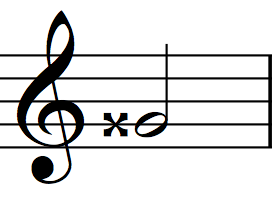
The double sharp looks like an ‘x.’
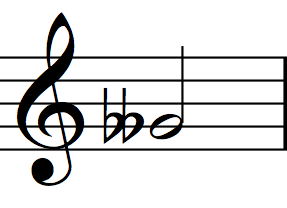
The double flat consists of two flat symbols.
Double sharps and double flats may seem unnecessarily bizarre. However, music theory presents logical reasons for their usage in music notation. If you are interested understand why, and in what circumstances, double sharps and double flats are used, please view this video.
Each measure below contains notes that are enharmonics. In the first measure, ‘G-double sharp ‘ is the same as ‘A’, which is the same as ‘B-double flat.’ Despite the different spellings, all three of these notes can be played on the second fret of the third string.
Let’s Play |
The study of music is a life-long adventure. You will most likely embark on a new musical endeavor upon completion of this series. But before you do, take a moment to reflect on your accomplishment. What has sight-reading developed in you? In what ways have you grown, not just musically, but in other aspects of your life as well? Take a moment to celebrate these new gifts! Well done!
Let’s Play Rhythms |
An audio element has been excluded from this version of the text. You can listen to it online here: https://press.rebus.community/sightreadingforguitar/?p=2654
An audio element has been excluded from this version of the text. You can listen to it online here: https://press.rebus.community/sightreadingforguitar/?p=2654
Let’s Play Patterns |
An audio element has been excluded from this version of the text. You can listen to it online here: https://press.rebus.community/sightreadingforguitar/?p=2654
An audio element has been excluded from this version of the text. You can listen to it online here: https://press.rebus.community/sightreadingforguitar/?p=2654
Let’s Play Duets |
Let’s Play Compositions |
These compositions are under the Creative Commons Attribution-NonCommercial 4.0 International License (CC BY-NC 4.0).
An audio element has been excluded from this version of the text. You can listen to it online here: https://press.rebus.community/sightreadingforguitar/?p=2654
To play Process III according to the El Ansary’s intentions you must abide by the string number indications. In this piece the standard method (not the Norman method) applies, meaning circled Arabic numerals represent string numbers.
An audio element has been excluded from this version of the text. You can listen to it online here: https://press.rebus.community/sightreadingforguitar/?p=2654
The next two pieces are at the level of advanced sight-reading. You may want to play each four times. First, clap the rhythms. Second, sight-read Guitar 1’s upper voice. Third, sight-read Guitar 1’s lower voice. And, finally, sight-read the entire Guitar 1 part.
An audio element has been excluded from this version of the text. You can listen to it online here: https://press.rebus.community/sightreadingforguitar/?p=2654
An audio element has been excluded from this version of the text. You can listen to it online here: https://press.rebus.community/sightreadingforguitar/?p=2654
You have completed this unit! If you kept up with the beat and accurately played approximately 70% of the pitches and rhythms, you are ready for the next unit. Feel free to repeat the exercises. However, do not play them so often that you memorize them. Once you memorize the notation, you are no longer developing the skill of sight-reading.
This is the last unit in the series. It consists of eight strategies to continue refining your sight-reading practice on your own. Most strategies discussed below include links to other relevant resources.
Dedicate at least fifteen minutes of each practice session to sight-reading. Your sight-reading skills will continue to improve and you will experience the additional benefit of encountering new music. Take time to find good sight-reading repertoire. I’ve included some recommendations below to get you started.
In this series, you have been formally introduced to fifth, seventh, ninth and twelfth positions. Yet you probably realize that guitarists can play in other positions as well. To develop the advanced skill of sight-reading in various positions, I suggest the following:
Listen to excellent performances of compositions and follow along with the scores. I prefer to use a hard copy. But if you prefer an online experience, listen and watch any of the countless YouTube postings of great musical performances combined with scores. I usually use the search terms ‘score’ or ‘scrolling score’ as well as the name of the composer and instrument(s) that interest me. For example, I found this while searching the terms: score, Villa-Lobos and guitar.
One recent study theorizes that regular improvisation practice contributes to better sight-reading.Mcpherson, Gary E., et al. “Path Analysis of a Theoretical Model to Describe the Relationship among Five Types of Musical Performance.” Journal of Research in Music Education, vol. 45, no. 1, 1997, pp. 103–129. It is worth noting that some the best composers (and sight-readers) in the Western musical tradition, such as J.S. Bach and Beethoven, were famous for their skill at improvisation.
This series only touched the surface of chord reading. Most guitarists work for years to sight-read harmonies with relative ease. Consider the following while developing this skill.
Knowledge of music-theory will certainly help sight-reading. You can practice scales and harmonies in different positions. For free, online and guided learning, I recommend MusicTheory.net as well as OpenMusicTheory.com.
The best way to recognize musical symbols is to notate music by hand, or with notation software (Sibelius, Finale etc.). You can print free staff paper via the Blank Sheet Music site. Take a few hours to notate some of your unique musical ideas. If composition is new to you, start by notating a melody or chord progression. If you are not drawn to composition, then notate an arrangement of your favorite song. Another useful activity is to create a guitar transcription. A transcription is a musical piece created for an instrumentation that differs from the original. Try turning a violin solo into a guitar piece.
You have completed the series! I hope this experience dramatically enhanced your sight-reading ability, expanded your sense of wonder, forged new pathways to your creativity and augmented your capacity for resilience and poise, especially while under pressure. May these virtues continue to enrich your life.
THE COLLECTIONS: SCORES AND AUDIO FILES
The Keep Going Method Scores – This is a collection of all the exercises and compositions included in the series. It is organized by unit and is intended for educational purposes.
[One PDF combining all the scores is coming soon!]
The Obelisks – This is a collection of duets composed by an internationally diverse group of composers. This collection can be used for performances as well as educational purposes.
[One PDF combining all the scores is coming soon!]
The Keep Going Method MP3s – This is a collection of all the play-along audio files to be used in coordination with The Keep Going Method Scores.
[All MP3s to a Google Drive folder and link the folder is coming soon!]
Chelsea Green is an associate professor of music at The American University in Cairo. She teaches music history, introductory ethnomusicology, music theory, music entrepreneurship and guitar performance. Drawing on her experience as a professional guitar soloist and ensemble player, Chelsea also directs the Cairo Guitar Collective (CGC) and the AUC Guitar Ensemble, both of which perform regularly throughout Egypt.
In 2018, CGC completed a US/Egyptian tour and full-length recording of the Egyptian Composers Project. For this project, four Egyptian composers created new works for the group. Chelsea also transcribes music for guitar. Her transcriptions of French art songs for guitar and voice are published and distributed by California Guitar Archives (CGA). CGA also distributes her full-length album, The Mélodies of Eric Satie and Reynaldo Hahn, performed by duo Les Copines (Risa Larson, soprano & Chelsea Green, guitars). In 2011, she published a philosophical article entitled Permission to Play: Obstacles and Open Spaces in Music-Making. The article describes how the phenomenon of play, as articulated by the philosopher Hans George Gadamer, relates to the performing arts.
In 2010, Chelsea was selected to participate in the month-long Asian Pacific Performance Exchange (APPEX) in Bali, Indonesia. During the exchange, artists from East Asia and the United States studied traditional Balinese performing arts and created collaborative performance pieces. Chelsea is also a co-founder of the Los Angeles Electric 8, an electric guitar octet. The octet’s repertoire spans the late Renaissance to today. During her six-year membership in the octet, the Los Angeles Electric 8 recorded three full-length albums and performed in a variety of US national festivals including the Strathmore Guitar Festival, Sundays Live at LACMA, REDCAT’s Summer Studio, World Festival of Sacred Music and MicroFest.
Chelsea holds a Doctorate of Musical Arts, with a specialization in guitar performance, from the University of California, Los Angeles.
John Baboukis is a professor of music at the American Uni. in Cairo. He teaches courses in music theory, musicianship, and music literature, teaches private lessons, directs the AUC Chamber Singers, and coaches chamber music ensembles.
Baboukis is the conductor of the Cairo Choral Society, a community chorus affiliated with the University in which students may also participate (either for course credit, or on a voluntary basis). Over the past twelve years, he has conducted them in performances of major works in the western choral repertory, including Charpentier’s Messe de minuit and Te Deum, Handel’s Messiah, Haydn’s Creation and Nelson Mass, Mendelssohn’s Elijah, Brahms’s German Requiem and Schicksalslied, Beethoven’s Mass in C and Choral Fantasy, Mozart’s Requiem, Stravinsky’s Symphony of Psalms, and Vivaldi’s Gloria. He is also the conductor of the Cairo Festival Orchestra, a professional ensemble which frequently accompanies the Cairo Choral Society, and which is being developed as an ensemble in residence at AUC.
He is the founder and co-director of the Lions of Cairo, an early music group composed primarily of AUC faculty, with whom he is a singer, qanoon player and harpsichordist. The Lions present regular performances of medieval, renaissance and baroque Western music, Byzantine chant and classical Arab music. He is a specialist in the performance of medieval and renaissance music, and was the founder and director of the Saint Paul Early Music Ensemble and Les voix médiévales de Montréal. He has also been trained in the performance of Byzantine Chant, and has served for many years as a chanter in the Orthodox Church. He has taught conducting and directed numerous choral and early music groups at the College of Saint Catherine (in Saint Paul, Minnesota), McGill University, the University of Georgia, Young Harris College and Illinois State University.
Baboukis holds a Doctor of Music degree from the Jacobs School of Music at Indiana University, where he was the first doctoral student ever permitted to submit an original composition (his Requiem Mass, for chorus, orchestra, and soloists) as a dissertation for a degree in choral conducting. He has written a substantial body of vocal music, as well as chamber works and music for piano, harpsichord, clavichord and organ. His concerto for bassoon and string orchestra, Three Walks in Zamalek, was premiered by the Cairo Symphony Orchestra in March of 2013, in a performance in which the composer was also the harpsichord soloist, and his Symphony for Cairo had its premiere performance, also by the Cairo Symphony, in June 2016. He has since conducted both works in a performance in Ewart Hall with the Cairo Festival Orchestra in March of 2017. He has been awarded a McKnight Composition Fellowship, and, in addition to receiving numerous private commissions, has twice won composer commissioning grants from the Jerome Foundation, through the American Composers Forum.
Bahaa El-Ansary is a composer and improvisor from Egypt, born in Cairo, 1991. He studied composition at The Academy of Arts in Cairo, Conservatoire de Bordeaux, Conservatoire de Boulogne-Billancourt, and is currently studying for a Master of Arts in Opera Making & Writing at the world-renowned Guildhall School of Music & Drama in collaboration with Royal Opera House. He also participated at The 46th International Summer Course for New Music in Darmstadt. In 2017, he co-founded Cairo Impro, a group that is dedicated to free improvisation via workshops and concerts.
Bahaa’s music is rooted in Arabic music and is also influenced by a list of master composers such as: György Ligeti, Iannis Xenakis, and John Cage, as well as many of Spectral Music and Avant-Garde music techniques. Bahaa composes what he calls “Energetic Music”.
Bahaa had been a Composer in Residence of The Royal Opera House & Shubbak Festival, ROH-Shubbak composers’ residency in London, Summer 2017. At some prestigious festivals and venues, Bahaa’s music has been performed throughout Europe and in the UK, Singapore, Lebanon, Egypt, and the US by some prestigious ensembles such as: Xenia Ensemble, Duo Harpverk, ECCMOP Ensemble, Egyptian Contemporary Music Ensemble, Musicians of LSO London Symphony Orchestra, Fear No Music, Cairo Guitar Collective, Friends of MATA, Ensemble Écoute, and Quatuor Apollinaire. His works have been performed at some of the following festivals: ESTOVEST Festival in Turin, Singapore Saxophone Symposium, American Arts Festival in Beirut, DCaf Downtown Contemporary Arts Festival in Cairo, Gaudeamus Muziekweek in Utrecht, Shubbak Festival in London, MATA Festival in New York, Cairo Contemporary Music Days in Cairo, Fete de la Musique in Paris, and World Saxophone Congress in Zagreb.
Ashraf Fouad is a composer, who teaches composition and theory at The American University in Cairo. He is a graduate of The Academy of Arts in Cairo, Egypt, and The Juilliard School of Music, New York, where he advanced to the level of DMA studies with David Diamond (1988–1991). At the Cairo Conservatory, he studied with Taha Nagy and Said Awad. At Juilliard, Fouad studied composition with Stanley Wolfe, Joseph Schwantner, and Bernard Rands. Among his works, which were premiered at Juilliard are: Sonata Concertante for Violin and Piano (Paul Hall) and String Quartet (Alice Tully Hall).
A working musician all his life, Fouad has been performer, producer, researcher, teacher, lecturer, and composer. In 1994, he joined the faculty at The American University in Cairo as composer-in-residence. Since then, he has written Ithaca (cantata for orchestra, chorus and soloists), a commission celebrating the 75th anniversary of the University. Other works composed, while at AUC include Afterthought, a song for tenor, soprano, violin, and piano; Longing, song for voice and piano; Cairo Tapestry, a work in collaboration with artist Paul Rinaldi in video and music; Tapestry Suite, for nine musicians; Silently I Wait, I admire Your Face, songs for voice and piano; Christmas Song, ensemble song for voice, harp, percussion and piano; In the Basement, tuba solo; New Jersey Girls, three songs for bass tuba, and piano; Love Cycle, four songs for voice and piano; Waheeda, a trio for vion, violoncello and piano; Sonata Piccola, piano sonata; Nature’s Angels, song for voice and piano; Toccata Moderna, for piano. In the Theater, Fouad wrote Octahedron, score for experimental theater and recorded the incidental music for Sophocles’s Antigone and performed live in Brecht’s A Man’s a Man with director Frank Bradley. Recent performances of Fouad’s works have been in Cairo and Alexandria, Egypt; Washington DC; Chicago; New York; Dublin; London; Vienna; Komaron; Slovakia; and Budapest, Hungary. Awards for his works have come from The Kennedy Center, Washington, DC, and the American Society of Composers, Authors, and Publishers (ASCAP).
I, Joan Greenwald, am a perpetual student, practitioner, and teacher of tai chi, qi gong and classical guitar. For music composition, I am following the brilliant inspiration of Theodore Norman (my 25 year mentor). We miss him dearly. Also a modern artist, I’ve spent a lifetime creating and showing my paintings and drawings. These endeavors combine and move together in the visual, aural and martial art worlds. Really they are all the same —just with slightly different expressions, all flow. Thank you for your attention.
Eric Kiersnowski is a musician and composer known for his unique playing and songwriting in projects including Godzik Pink, Rats, his current projects FeatherWolf, OxOx, Upsilon Acrux, Totally Serious, Los Angeles Electric 8 and others. In 2018, he completed his first album performing his own original works for solo classical guitar
Paweł Kuźma (b. 1985, Piekary Śląskie, Poland) is an adjunct professor at The American University in Cairo where he teaches world music and private applied guitar. In fall 2017, Pawel became co-director of the Cairo Guitar Collective. Along with composer Bahaa El Ansary, Pawel also co-directs Cairo Impro, a group dedicated to the education and performance of avant-garde improvisation. As a performing artist, Pawel has given many concerts in Poland, Finland, Germany, Czech Republic, Austria and, more recently, Egypt.
His passion for classical guitar started in his first year of primary school. At the beginning of his musical education, Pawel won many national music competitions. Later, he won international competitions and grants from the Polish Ministry of Culture and City Council.
Considered by many to be one of the most promising guitarists in Poland, Pawel graduated from high school with honors. Pawel continued his education at the Szymanowski Music Academy in Katowice, Poland. There, he studied under the renowned professor, Alina Gruszka. During this time, Pawel was awarded a grant by Young Poland, an organization founded by Ministry of Culture.
After graduating from the Szymanowski Academy, Pawel moved to Finland to continue his education at the Sibelius Academy in Helsinki, which is widely considered to be one of the best music programs in the world. Pawel studied under Dr. Jukka Savijoki.
Walter Marsh pursued a life in music as a classical guitarist from 1988 to 1995 (and sporadically in years following) studying with Theodore Norman at UCLA, where he earned a Master of Fine Arts degree in guitar performance in 1995. His work as a soloist and as a founding member of the Modern Arts Guitar Quartet transitioned to work as a teacher and then into the world of nonprofit arts management where he works today. As a guitarist, Walter has had a particular focus on modern music, inspired by his mentor, Theodore Norman, who was the subject of his MFA thesis. In it, he explored the performance practice of Norman’s music for solo guitar and his unique place in the instrument’s history. Since 2012, Walter has been a member of ensembleFRET, a Los Angeles based group whose core instruments are mandolin, guitar and arpeggione.
Brandon Mayer is originally fromFlorida. He attended UCLA and Universityof Barcelona earning, degrees in music and anthropology. At UCLA he studied classical guitar with Peter Yates and Theodore Norman. As an ensemble and solo artist, Mayer has performed and toured extensively, including at LA CountyMuseum of Art, UCLA HammerMuseum, USC, Kennedy Center (DC), Manhattan School of Music, and as artist-in-residence at University of Kansas. A prolific singer-songwriter, he has released multiple recordings and collaborations associating with labels Pelvic, VillageVert, and Range Life. Also a composer, Mayerhas contributed music for theater and films that have been produced/screened at festivals throughout the U.S., Europe, andAsia. Currently, he teaches at Bahcesehir University (Istanbul) and UCLA.
Mark Popeney (b. 1982, San Diego, California, USA) is a composer whose music spans many styles and media. His music has been performed by such groups as Ensemble Signal, the USC Thornton Symphony, the Tuscaloosa New Music Collective, and the Harvard University Choral Fellows. His musical, irl (In Real Life) was premiered by Hooligan Theater Company in 2011.
Mark received his Doctor of Musical Arts in Composition from the University of Southern California Thornton School of Music in 2012, where he studied with Stephen Hartke and Donald Crockett. Mark earned his Master’s degree from the University of California, Los Angeles in 2007, studying with David Lefkowitz and Ian Krouse, and his Bachelor’s degree in 2004 from the University of California, Berkeley.
Mark teaches music at Bunker Hill Community College in Boston, MA, where he also serves as chair of the Performing Arts Department. Mark is an avid singer, guitarist, and producer, and is a founding member of the rock quintet Dream Hydra.
https://soundcloud.com/mpopeney
https://soundcloud.com/dream-hydra
Emile Porée is a jazz musician and vocalist who enjoys performing to a broad music-loving audience. Either solo, or with his trio, he fuses many musical genres. To this end, Emile considers himself a musical activist. Today, Emile is recording his own music and performing on the local music scene in Los Angeles, with bands and other various artists. It’s no wonder that bands and producers are big supporters and advocates of Emile. One of Emile’s passion projects has been the documentation of jazz in Los Angeles, exploring and recording the soundscapes and images of the city’s musicians.
Felix Salazar was born in Los Angeles, California, Felix is a composer, producer, photographer and guitarist. He received an M.F.A. in Composition from the California Institute of the Arts (CalArts) and a B.A. in Commercial Music from California State Polytechnic University Pomona.
Felix is the director and primary arranger of Los Angeles Electric 8, a chamber group of eight electric guitarists. He is also a guitarist and composer of the technical rock band FeatherWolf and improvisation group Doctor9. In an attempt to break certain stereotypes associated with photography, the electric guitar, and chamber music, Felix blends preconceived ideas, all the while experimenting with fields and the depths of space.
He specializes in guitar photography working with Guild Guitars, Guitar Salon International and Cordoba Guitars. Felix also produces and promotes performances in Los Angeles, working with production companies & venues: Red Bull Music Academy, Red Bull Radio, The New York Guitar Festival, Rum & Humble, Spaceland Presents, The Echo & Echoplex, dublab, SASSAS, The Regent Theater, KJAZZ 88.1 FM, Santa Monica Pier Twilight Concert Series, Simi Valley Cajun & Blues Festival, World Festival of Sacred Music and the Hollywood Bowl. .
Felix hopes that his productions, arrangements and compositions will expose people to fresh and inspiring music. In his free time, Felix also maintains microcosms of various tropical plant and aquatic life.
http://www.doctor9primarycare.com/
Peter Yates is a guitarist and composer whose interest in things not usually done has led to works for prepared guitar, building and playing an arpeggione (a bowed guitar invented in 1823 and rarely seen since), cycles of “PopArt” songs, a puppet opera about the Watts Towers, and a DVD ghost-town opera in which historic photographs come to life and sing. Recent performance activity has included recording and performing with the trio ensembleFRET and the duo GuitAria. His work with the Elgart/Yates Duo included sixteen tours of Europe, over one hundred premieres, and a book on prepared guitar. His works have been performed on Italian National Radio (RAI), microfest, The Living Arts Festival, NOW Festival, Festival of American Music, in Mexico, Europe and across the United States. His performances and compositions are recorded on Reference Recordings, Innova, Centaur, Bridge and TR Records. He is on the faculties of music at UCLA and at the California State Polytechnic University, Pomona. Examples of his work can be found at California Guitar Archives (calguitar.com) and youtube/peterfyates.
“A particularly lucid fretboard dreamer. An unreconstructed modernist, he is also sensitive to vernacular and popular styles.” – The Los Angeles Times
If you have adopted this book or made a revised/adapted version for a course, please let us know on the adoption form for the Sight Reading for Guitar: The Keep Going Method open textbook (embedded below).
An interactive or media element has been excluded from this version of the text. You can view it online here: https://press.rebus.community/sightreadingforguitar/?p=4173
This material is based on original work by Christina Hendricks; in Introduction to Philosophy: Philosophy of Mind, edited by Heather Salazar and Christina Hendricks, and produced with support from the Rebus Community. The original is freely available under the terms of the CC BY 4.0 license at https://press.rebus.community/intro-to-phil-of-mind/back-matter/adoption-form/.
This book is licensed CC BY (Creative Commons Attribution 4.0) except where otherwise noted. This license allows for reuse, adaptation, remixing and redistribution of content, so long as you attribute it to the original author(s), indicate if changes are made, and link to the original, free content, found at https://press.rebus.community/sightreadingforguitar/.
Additionally, most duets in the Let’s Play Compositions category are licensed CC BY-NC (Creative Commons Attribution-NonCommercial 4.0). This license bears the same stipulations as CC BY, plus an additional stipulation that the content may not be used for commercial purposes. This additional license was adopted in large part to honor the composers who generously contributed their duets to the series.
The chapters in these books, compositions, and transcriptions are all original works—copyright of their authors—who have agreed to release these works under the CC BY license (except where otherwise noted). If you plan on adapting some, or parts, of the book, videos, audio files or compositions, please let us know in the Rebus Community platform and by filling out our adoption form. Be sure to attribute the original creators, as required by the license (see Suggested Attributions below).
If you would like to make revisions or adaptations, please be mindful that according to the terms of the license, you must not do so in a way that suggests the original authors agree with the changes you have made. You may do so by using the sample attribution for revised versions, below. Minor spelling or typo changes usually do not count as revisions or adaptations, according to the CC BY license (see the Creative Commons FAQ on adaptations).
See also the Creative Commons FAQ on attribution, and also best practices for attribution.
This material is created by Chelsea Green; with contributions from John Baboukis, Bahaa El-Ansary, Ashraf Fouad, Joan Greenwald, Eric Kiersnowski, Pawel Kuźma, Walter Marsh, Brandon Mayer, Mark Popeney, Emile Porée, Felix Salazar, Peter Yates, and produced with support from the Centre for Learning and Teaching at The American University in Cairo and Rebus Community. The original is freely available under the terms of the CC BY 4.0 license at https://press.rebus.community/sightreadingforguitar/.
This material is a revised/adapted version of original work by Chelsea Green; with contributions from John Baboukis, Bahaa El-Ansary, Ashraf Fouad, Joan Greenwald, Eric Kiersnowski, Pawel Kuźma, Walter Marsh, Brandon Mayer, Mark Popeney, Emile Porée, Felix Salazar, Peter Yates, and produced with support from the Centre for Learning and Teaching at The American University in Cairo and Rebus Community. The original is freely available under the terms of the CC BY 4.0 license at https://press.rebus.community/sightreadingforguitar/.
This material is [created by or based on] original work by Chelsea Green; in Sight Reading for Guitar: The Keep Going Method, authored by Chelsea Green, with contributions from John Baboukis, Bahaa El-Ansary, Ashraf Fouad, Joan Greenwald, Eric Kiersnowski, Pawel Kuźma, Walter Marsh, Brandon Mayer, Mark Popeney, Emile Porée, Felix Salazar, Peter Yates, and produced with support from the Centre for Learning and Teaching at The American University in Cairo and Rebus Community. The original is freely available under the terms of the CC BY 4.0 license at https://press.rebus.community/sightreadingforguitar/.
This material is by [composer’s name], in Sight-Reading for Guitar: The Keep Going Method Book & Video Series, authored by Chelsea Green and produced with support from the Rebus Community. The original is freely available under the terms of the CC BY-NC 4.0 license at https://press.rebus.community/sightreadingforguitar/.
This material is a revised or adapted version of an original composition by [composer’s name], in Sight-Reading for Guitar: The Keep Going Method Book & Video Series, authored by Chelsea Green and produced with support from the Rebus Community. The original is freely available under the terms of the CC BY-NC 4.0 license at https://press.rebus.community/sightreadingforguitar/.
*This material is a revised/adapted version of original work by Christina Hendricks, and produced with support from the Rebus Community. The original is freely available under the terms of the CC BY 4.0 license at https://press.rebus.community/intro-to-phil-of-mind/.
Sight Reading for Guitar: The Keep Going Method Book and Video Series was produced with support from the Rebus Community, a charity building a new, collaborative model for publishing open textbooks. Critical to the success of this model is including mechanisms to ensure that open textbooks produced with the Community are high quality, and meet the needs of all students who will one day use them.
As a result, this book has undergone peer review by five subject experts, each reviewing five units of the book. The reviewers were largely music teachers or music professors, at colleges and universities across North America. Reviews were structured around considerations of the intended audience of the book, and examined the comprehensiveness, accuracy, and relevance of content. See the Rebus Community Review Guide for more details.
Chelsea, Nadine, Maha, Ahmed, and the team at Rebus would like to thank the review team for the time, care and commitment they contributed to the project. We recognize that volunteering to review the book without compensation is a generous act of service on their part. This book would not be the robust, valuable resource that it is were it not for their feedback and input.
We are working to create a new, collaborative model for publishing open textbooks. Critical to our success in reaching this goal is to ensure that all books produced using that model meet the needs of all those who will one day use them. To us, open means inclusive, so for a book to be open, it must also be accessible.
As a result, we are working with accessibility experts and others in the OER community to develop best practices for creating accessible open textbooks, and are building those practices into the Rebus model of publishing. By doing this, we hope to ensure that all books produced using the Rebus Community are accessible by default, and require an absolute minimum of remediation or adaptation to meet any individual reader’s needs.
While we work on developing guidelines and implementing support for authoring accessible content, we are making a good faith effort to ensure that books produced with our support meet accessibility standards wherever possible, and to highlight areas where we know there is work to do. It is our hope that by being transparent on our current books, we can begin the process of making sure that accessibility is top of mind for all authors, adopters, students, and contributors of all kinds on all our open textbook projects.
Below is a short assessment of eight key areas that have been assessed during the production process. The checklist has been drawn from the BCcampus Open Education Accessibility Toolkit. While a checklist such as this is just one part of a holistic approach to accessibility, it is one way to begin our work on embedded good accessibility practices in the books we support.
Wherever possible, we have identified ways in which anyone may contribute their expertise to improve the accessibility of this text.
We also welcome any feedback from anyone who encounters the book and identifies an issue that needs resolving. This book is an ongoing project and will be updated as needed. If you would like to submit a correction or suggestion, please do so using the Rebus Community Accessibility Suggestions form.
| Area of Focus | Requirements | Pass? |
|---|---|---|
| Organizing Content | Content is organized under headings and subheadings | Yes |
| Organizing Content | Headings and subheadings are used sequentially (e.g. Heading 1. Heading 2, etc.) as well as logically (if the title if Heading 1 then there should be no other Heading 1 styles as the title is the uppermost level) | Yes |
| Images | Images that convey information include Alternative Text (alt-text) descriptions of the image’s content or function | Yes |
| Images | Graphs, charts, and maps also include contextual or supporting details in the text surrounding the image | Not Applicable |
| Images | Images do not rely on colour to convey information | Yes |
| Images | Images that are purely decorative contain empty alternative text descriptions. (Descriptive text is unnecessary if the image doesn’t convey contextual content information) | Yes |
| Tables | Tables include row and column headers | No |
| Tables | Tables include a title or caption | No |
| Tables | Tables do not have merged or split cells | Yes |
| Tables | Tables have adequate cell padding | Yes |
| Weblinks | The weblink is meaningful in context, and does not use generic text such as “click here” or “read more” | Yes |
| Weblinks | Weblinks do not open new windows or tabs | No |
| Weblinks | If weblinks must open in a new window, a textual reference is included in the link information | Yes |
| Embedded Multimedia | A transcript has been made available for a multimedia resource that includes audio narration or instruction* | No |
| Embedded Multimedia | Captions of all speech content and relevant non-speech content are included in the multimedia resource that includes audio synchronized with a video presentation | No |
| Embedded Multimedia | Audio descriptions of contextual visuals (graphs, charts, etc.) are included in the multimedia resource | Not Applicable |
| Formulas | Formulas have been created using MathML | Not Applicable |
| Formulas | Formulas are images with alternative text descriptions, if MathML is not an option | Not Applicable |
| Font Size | Font size is 12 point or higher for body text | Yes |
| Font Size | Font size is 9 point for footnotes or endnotes | Yes |
| Font Size | Font size can be zoomed to 200% | Yes |
*Transcript includes:
This page provides a record of edits and changes made to this book since its initial publication. Whenever edits or updates are made in the text, we provide a record and description of those changes here. If the change is minor, the version number increases by 0.1. If the edits involve substantial updates, the edition number increases to the next whole number.
The files posted alongside this book always reflect the most recent version. If you find an error in this book, please let us know in the Rebus Community project home.
| Version | Date | Change | Affected Web Page |
|---|---|---|---|
| 1.0 | 2 April 2020 | Original |